

William Stopford
Every SUV, ute and van discontinued in Australia in 2025
1 Hour Ago
The new Isuzu MU-X is a big improvement, but can a top-of-the-range LS-T variant compete with a Toyota Prado VX in more ways than price?

Senior Contributor
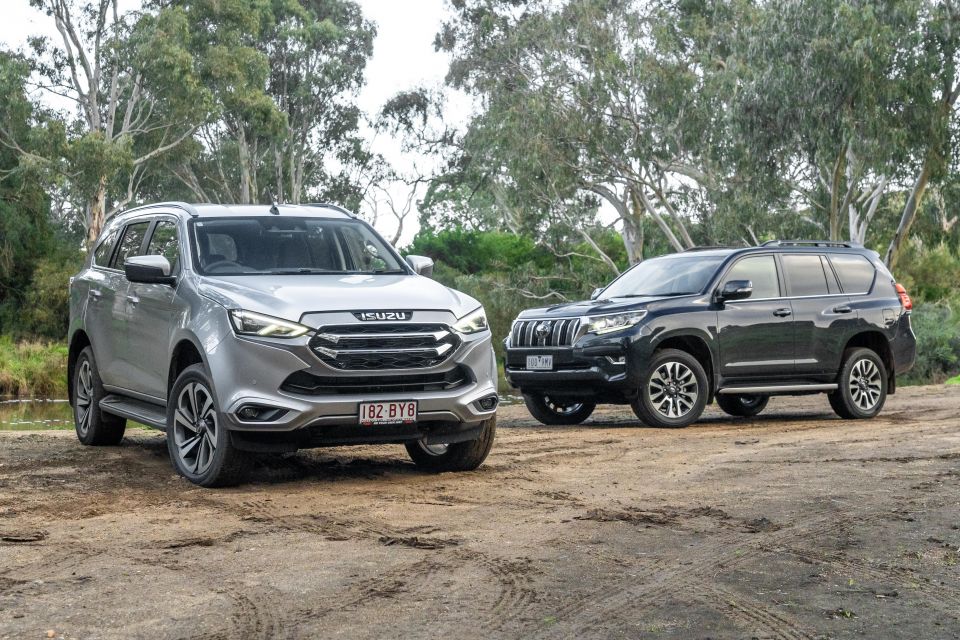

Senior Contributor
Isuzu Ute has just launched its second-generation MU-X in Australia – a substantial upgrade on the old model.
Where its predecessor gained a following due to keen pricing and a rugged reputation – Australia is the world’s second-largest MU-X market – the new model is more sophisticated.
As a package I’d now have it ahead of fellow pickup-based off-roaders the Mitsubishi Pajero Sport or Ford Everest, having spent time in all three. It beats the former in comfort and performance and the latter on value.
But knocking off the king is a bigger challenge. Yes the Toyota Prado is a more expensive proposition, but nevertheless it remains by some margin the top-selling large SUV in the country. People are evidently willing to pay for a product they deem superior.
If Isuzu Ute Australia is serious about making further inroads with its second iteration diesel SUV, then it simply must take it up to the Prado.
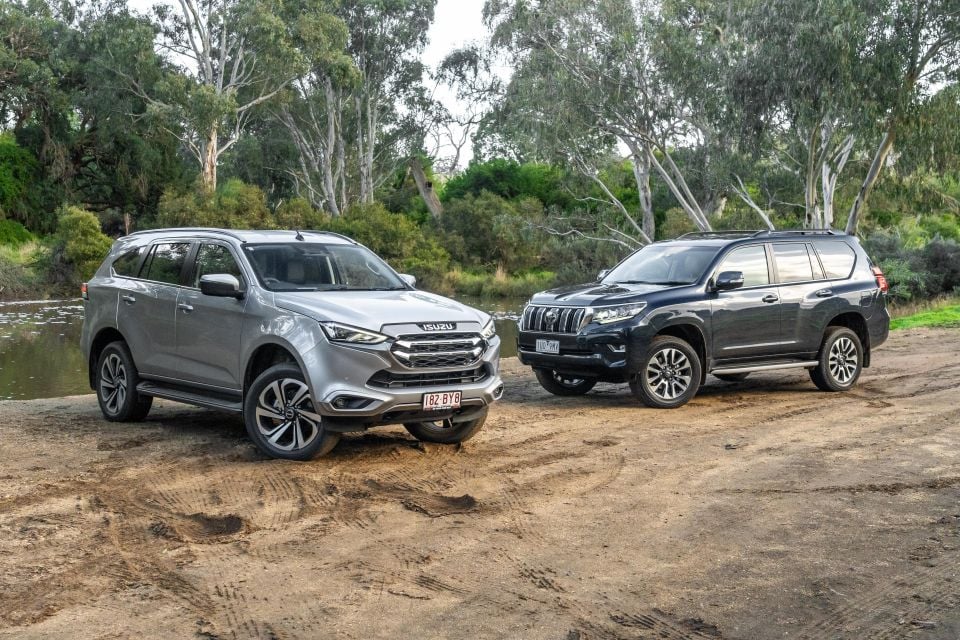
The Isuzu MU-X is offered in three specification grades called LS-M, LS-U and LS-T, with either 4×2 or 4×4 drivetrains – the latter for an additional $6000.
We’re testing the top-of-the-range LS-T 4×4 version here, which wears a recommended retail price of $65,990 before on-road costs.
By contrast the Prado comes in four levels of specification called GX, GXL, VX, and Kakadu.
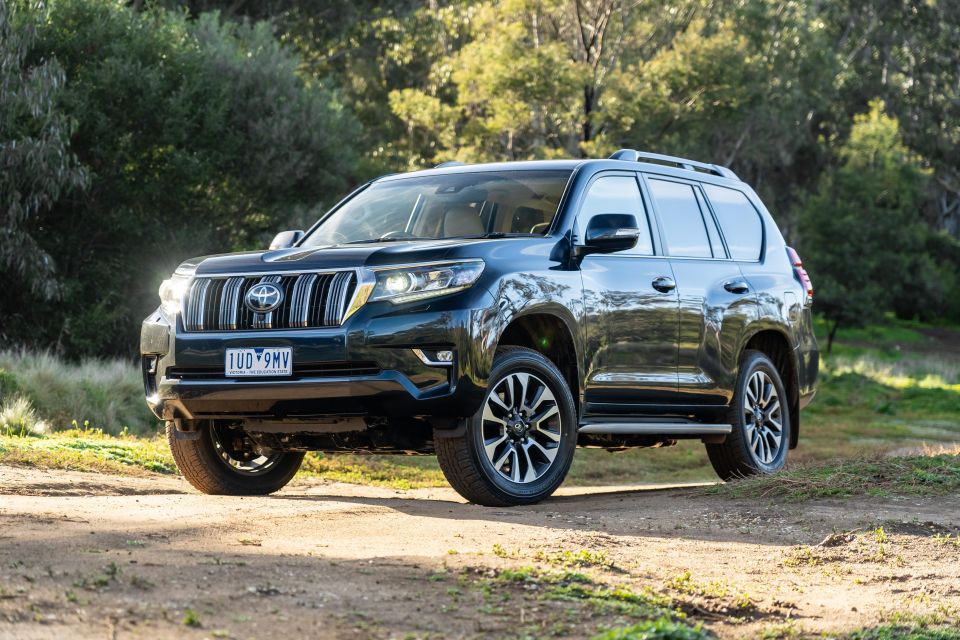
The Prado GXL 4×4 which is $67,530 before on-road costs and lines up best against the flagship Isuzu on price. But the variant we’ve secured for this test is the more luxurious Prado VX at $77,157 before on-road costs.
We will be sure to describe both the GXL and VX in the equipment sections to give you as much information as possible.
In the real world the price gap is wider. Isuzu Ute Australia is offering a sharper deal on the range-topping MU-X from launch day, whereas Toyota has no such national deals in place. Keep in mind, these come and go.
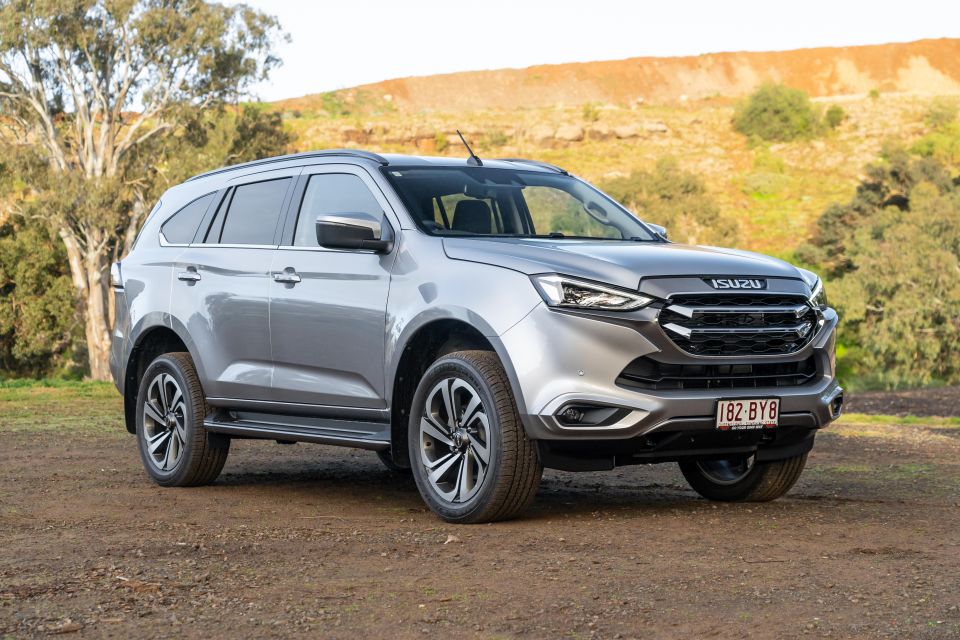
The Isuzu MU-X LS-T 4×4’s actual advertised drive-away price is $63,990. Using the drive-away calculator on Toyota’s site with a Melbourne postcode, the drive-away prices for the Prado GXL and XV respectively are $74,011 and $84,655.
Vehicles tested drive-away prices:
In short, the flagship MU-X undercuts even a low-grade Prado on price, and a similarly luxurious model is about $20,000 more expensive.
MORE: 2022 Isuzu MU-X price and specs MORE: 2021 Toyota Prado price and specs
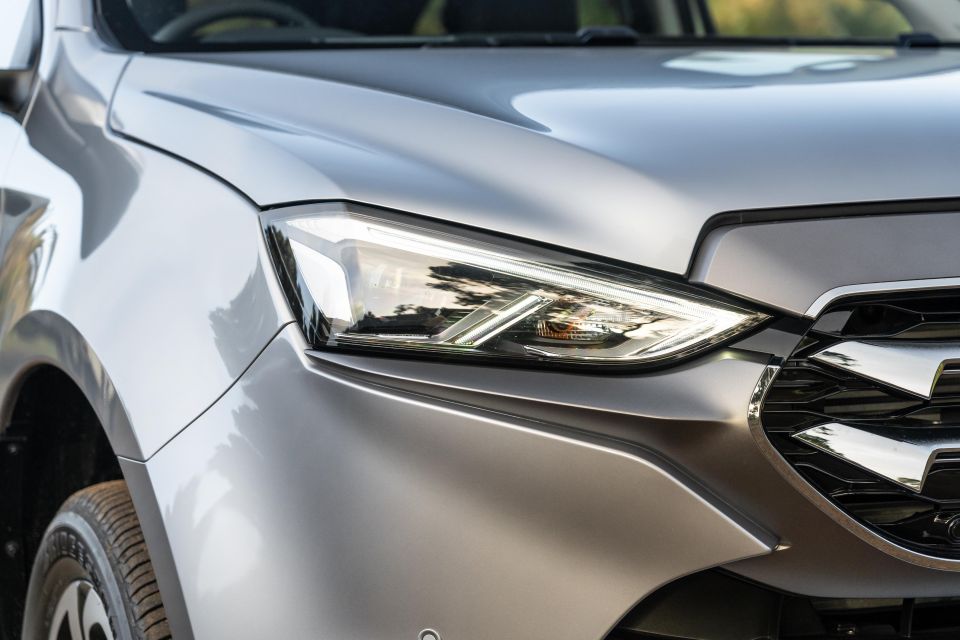
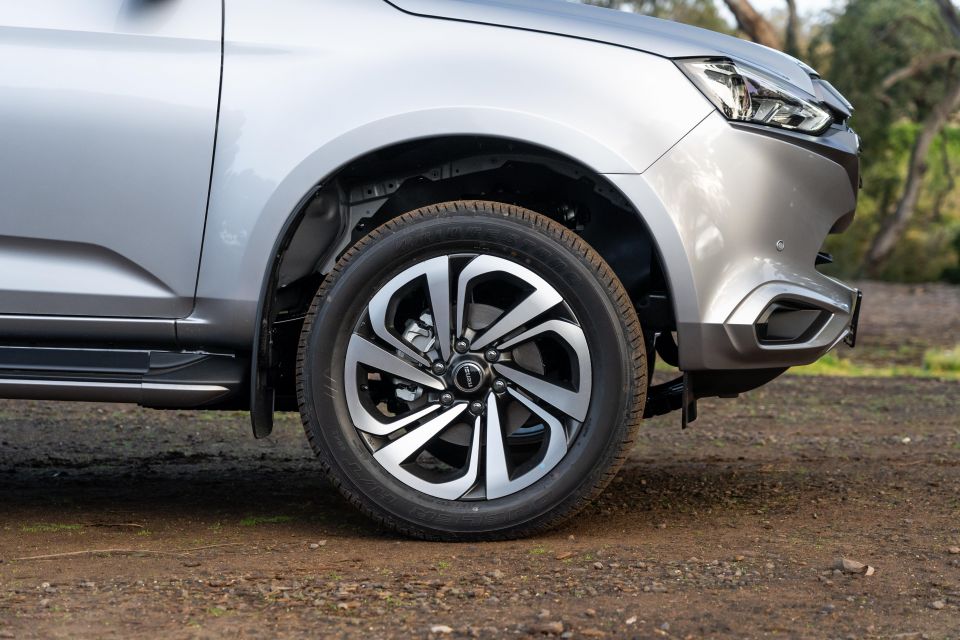
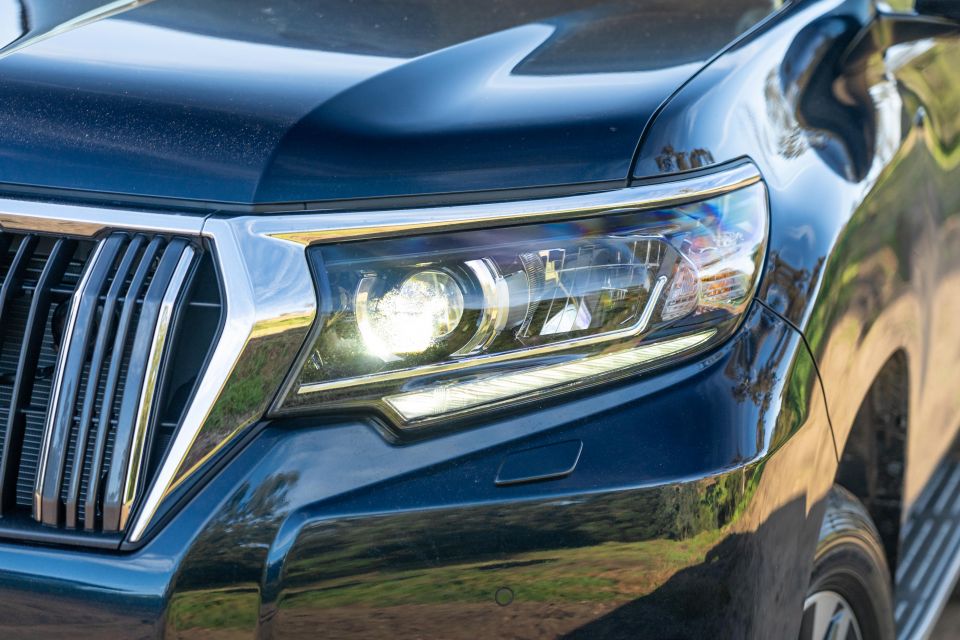
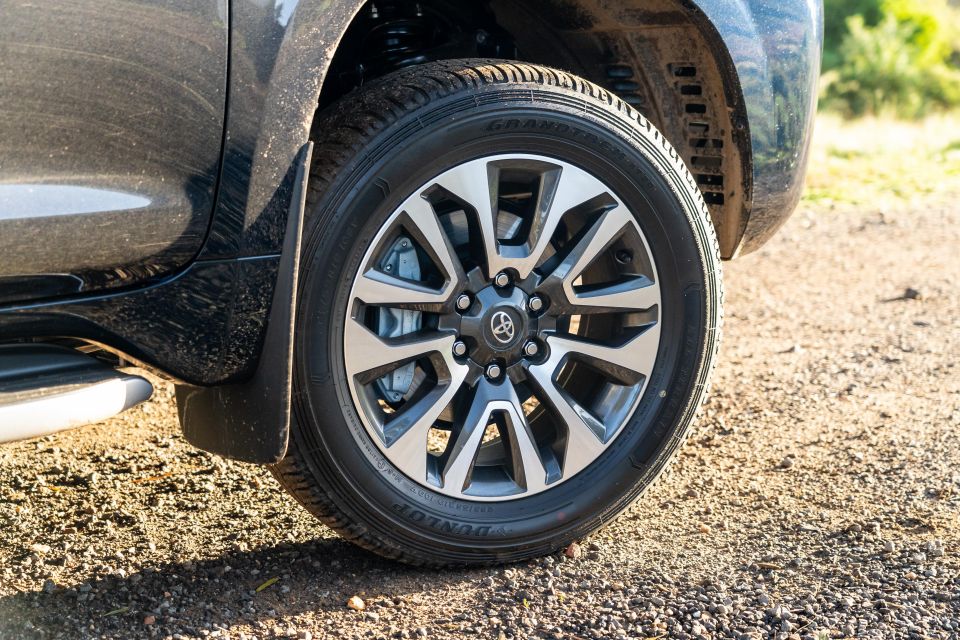
Both the Isuzu MU-X LS-T and the Toyota Prado VX come with exterior features such as:
The Isuzu adds 20-inch wheels with highway tyres compared to the Toyota’s 19″ on all-terrain rubber, a powered tailgate, and remote start function.
The Prado has backlit illuminated side steps for night use.
| Isuzu MU-X LS-T | Toyota Prado VX | |
|---|---|---|
| Wheels | 20-inch alloy | 19-inch alloy |
| Spare | Full-size | Full-size |
| Headlights | Bi-LED | Bi-LED |
| Dusk sensors | Standard | Standard |
| Daytime lights | LED | LED |
| Privacy glass | Standard | Standard |
| Roof rails | Standard | Standard |
| Tailgate | Powered | Manual |
| Side steps | Standard | Illuminated |
| Auto wipers | Standard | Standard |
| Proximity key | Standard | Standard |
| Rear sensors | Standard | Standard |
| Front sensors | Standard | Standard |
| Remote start | Standard | No |
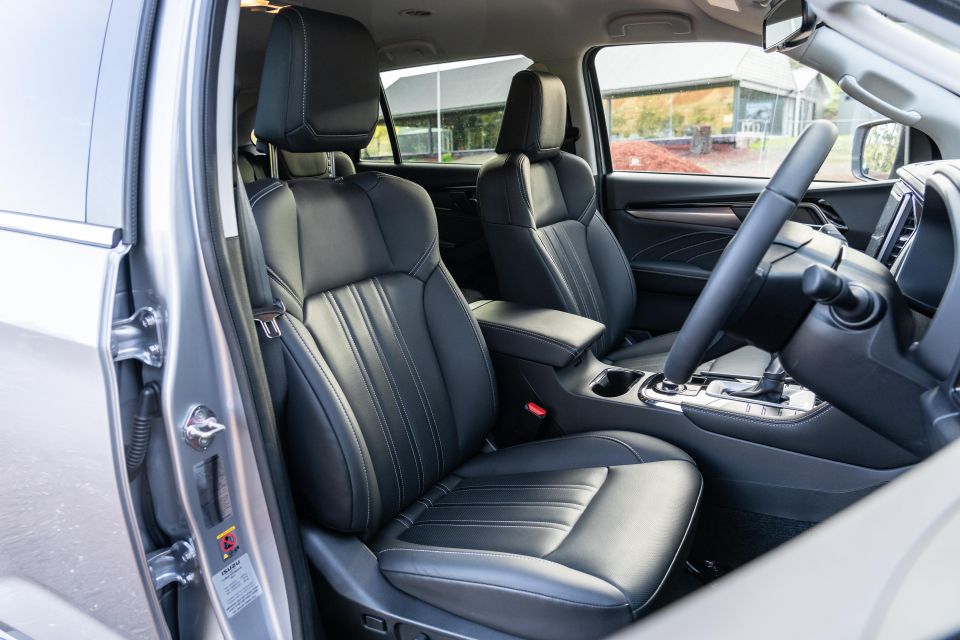

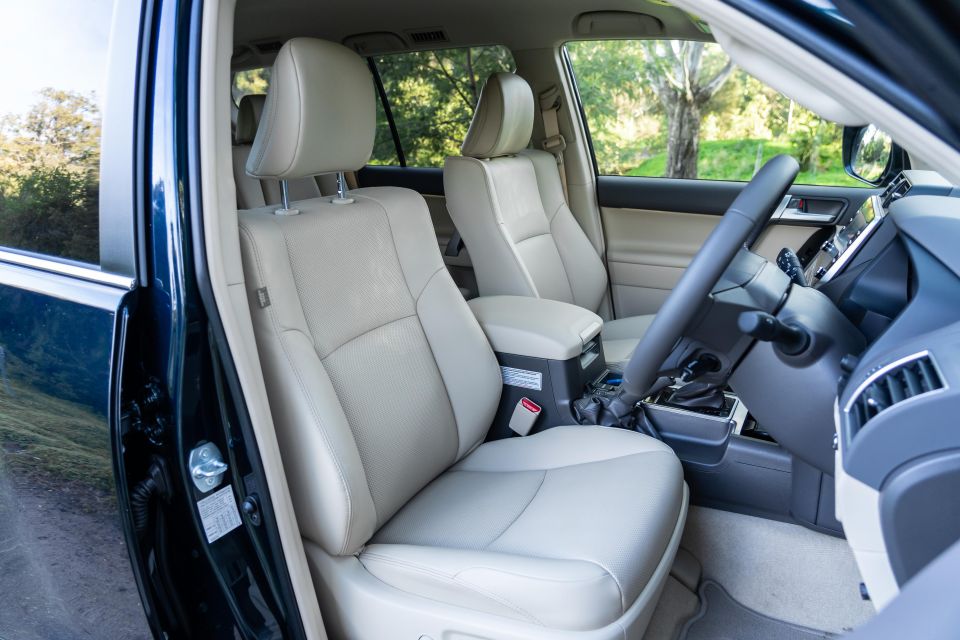
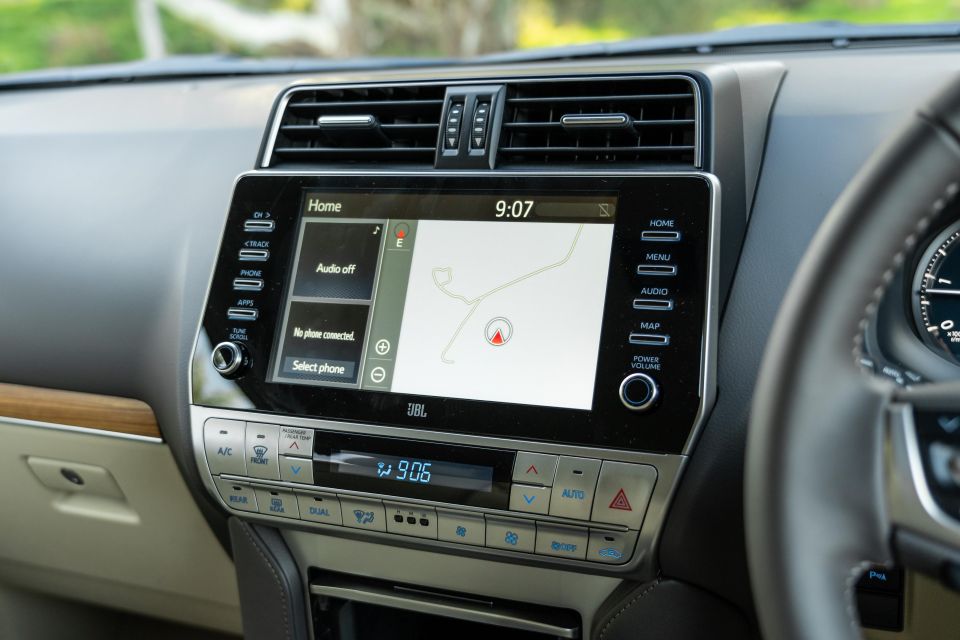
Inside both the Isuzu and Toyota share:
The Toyota Prado VX comes with extras above this such as front-seat ventilation, rear outboard seat heating, a refrigerated cooler box, powered steering wheel adjustment, an extra zone for the climate control, a 14-speaker sound system versus the MU-X’s eight, and a 360-degree camera system.
| Isuzu MU-X LS-T | Toyota Prado VX | |
|---|---|---|
| Seat trim | Leather accented | Leather accented |
| Driver’s seat | Powered, heated | Powered, heated, ventilated |
| Front-passenger seat | Powered, heated | Powered, heated, ventilated |
| Rear seat heating | No | Standard |
| Steering wheel adust | Tilt and telescope, manual | Tilt and telescope, powered |
| Rear-view mirror | Auto-dimming | Auto-dimming |
| Air-con system | 2-zone climate control | 3-zone climate control |
| Refrigerated cooler | No | Standard |
| Digital speedo | Standard | Standard |
| Touchscreen size | 9.0-inch | 9.0-inch |
| Satellite navigation | Standard | Standard |
| Apple CarPlay | Standard | Standard |
| Android Auto | Standard | Standard |
| Digital radio | Standard | Standard |
| Speakers | 8 | 14 (JBL system) |
| Parking camera | Rear-view | 360-degree |
Toyota Prado VX v Prado GXL
The differences in spec between the Prado VX and roughly $10,000 cheaper Prado GXL are the following:
Additional features in the VX over the GLX are:
As a compromise you can pay $3470 to add the VX’s heated, cooled and powered leather seats to the GXL.
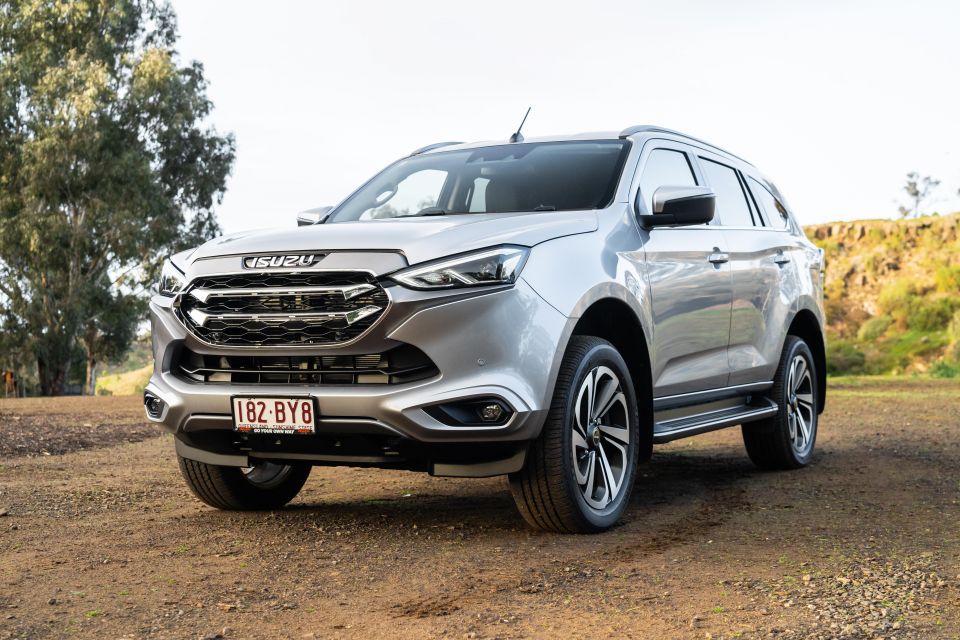
Both vehicles come fitted with dual front, front-side, curtain, and driver’s knee airbags, plus child-seat attachments in the middle row.
Active safety systems fitted to both include forward autonomous emergency braking, lane-departure warning, lane-keep assist, blind-spot monitoring, rear cross-traffic alert, adaptive cruise control, automatic high-beam headlights, and road sign assist.
The Isuzu adds AEB with junction assist, a front-centre airbag for head clashes, and misacceleration mitigation. It also has a more effective lane-keeping aid that uses steering corrections instead of selective wheel braking like the Toyota does.
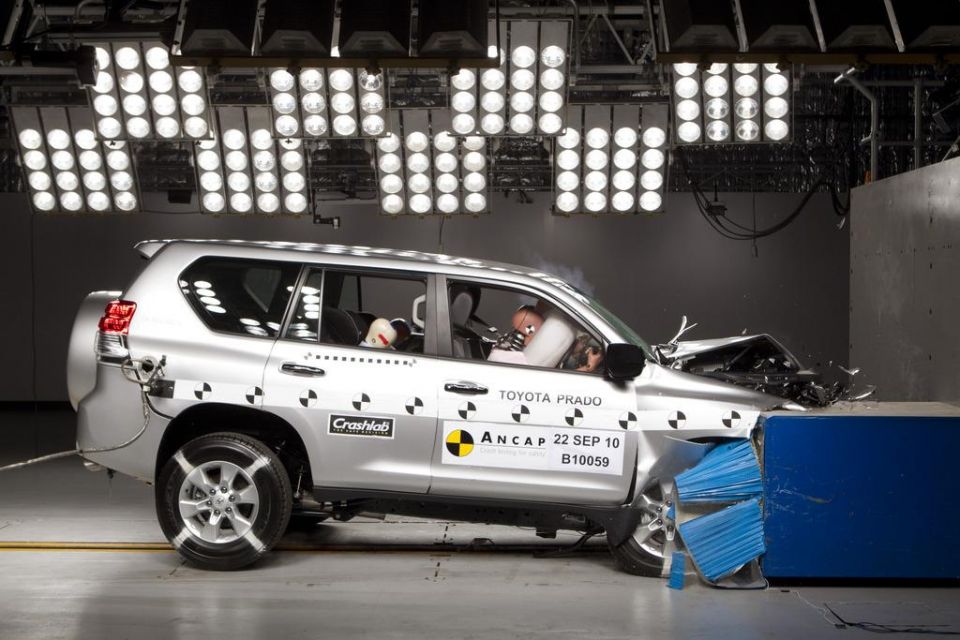
The Toyota’s safety systems are easier to adjust, via either specific buttons or the simple trip computer, than the occasionally fiddly Isuzu which has a user interface that leaves a bit to be desired.
In terms of independent crash testing by ANCAP only the Toyota has been tested. It has a five-star rating but from way back in 2011. The Isuzu MU-X’s ANCAP test results will come soon, and considering the D-Max ute achieved five stars in 2020 there’s reason enough to be confident.
But as yet, we don’t know for certain.
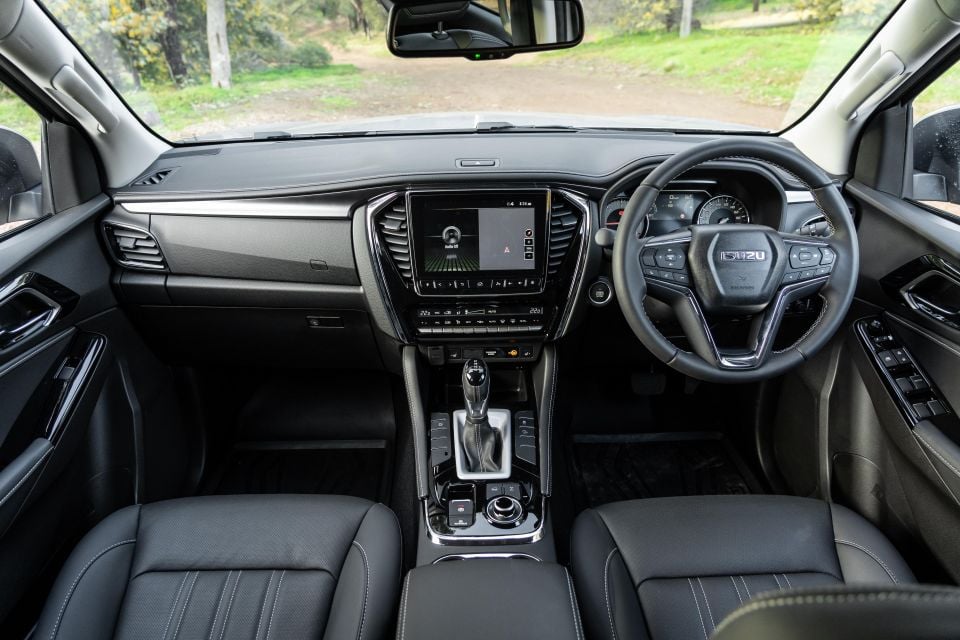
Isuzu
Isuzu’s new MU-X shares most of its features and layout with the D-Max, and is therefore a significant improvement on the old model.
The nicer new steering wheel finally moves telescopically, the heated bucket seats are more generously bolstered and power-adjustable, the digital driver display is more useful and sophisticated, and the gauges no longer look like something from the early ’90s.
Moreover there’s a real upgrade in terms of material quality: from the wheel’s leather rim and damped buttons, the padded dash top and knee rests, contrast stitching, cushioned arm rests, climate control rocker switches, new electric parking brake button, and ambient night lighting.
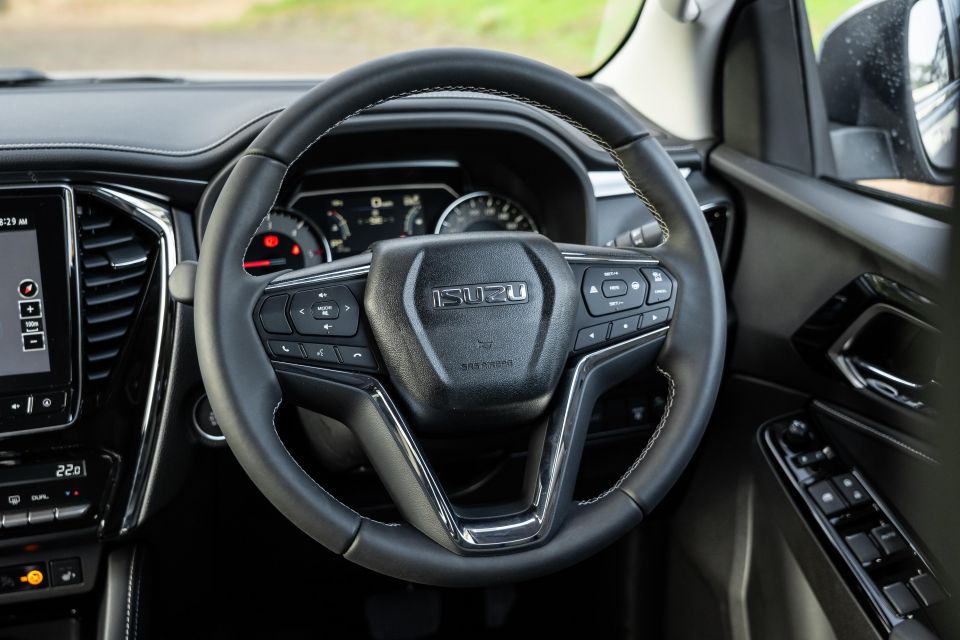
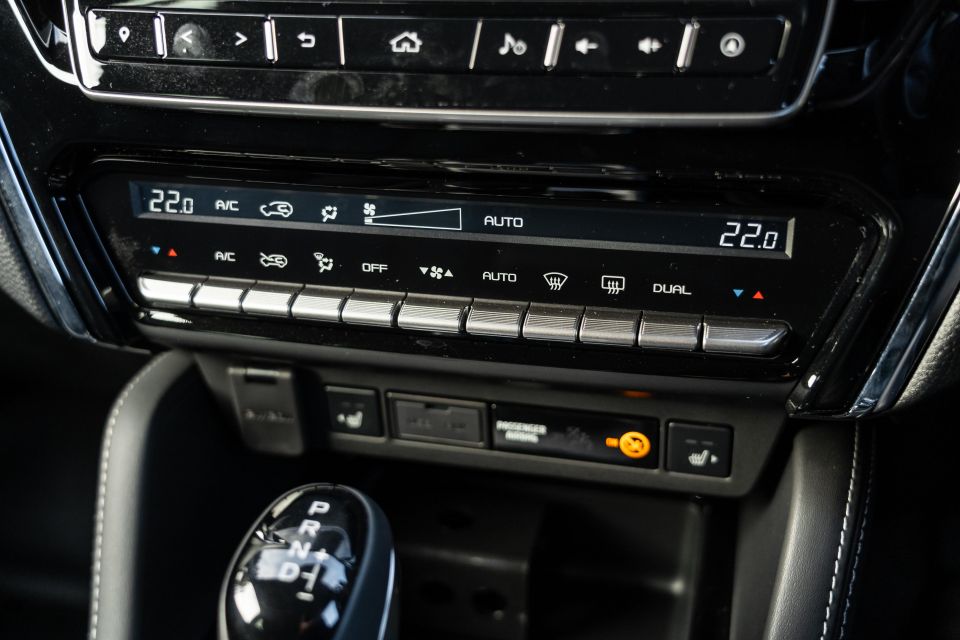
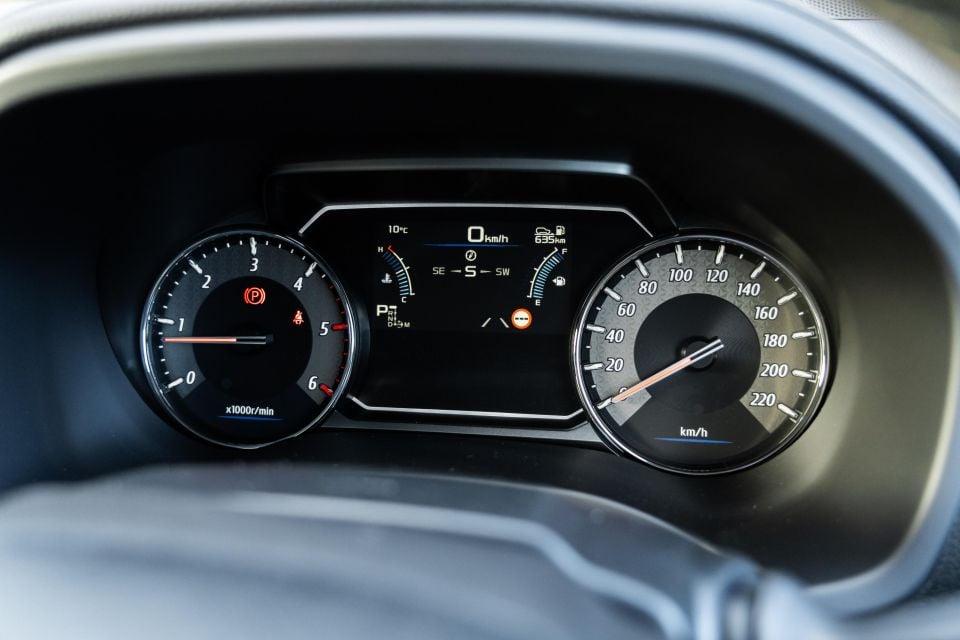
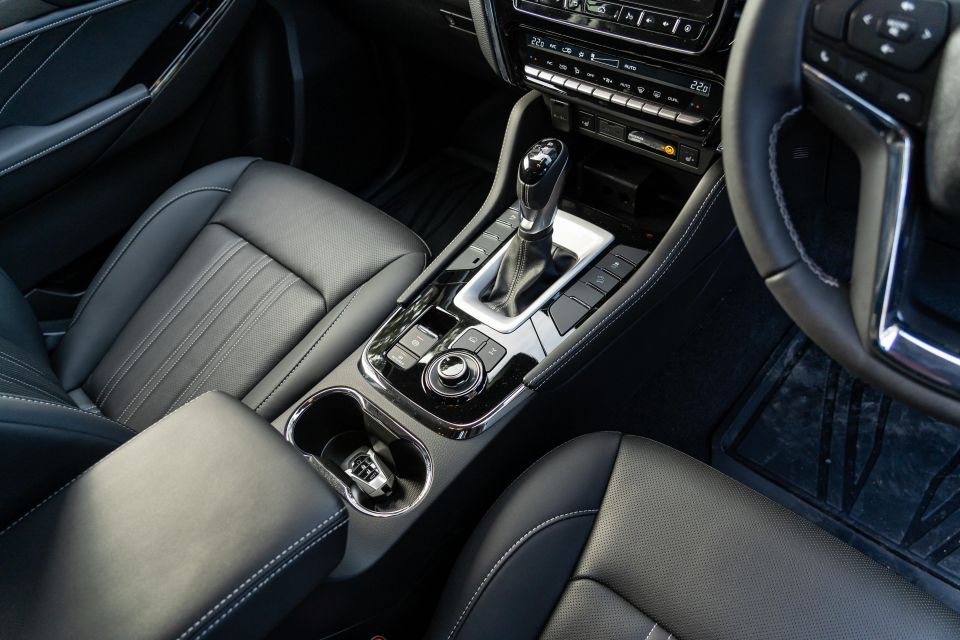
There is no shortage of storage options including two stacked gloveboxes, four front cupholders including two that come out like drawers from the dash, bottle-ready door bins, an open area below the centre fascia, and a sunglasses holder in the roof.
That new 9.0-inch centre display sits flush in the dash and has simple but clear maps, digital radio, wireless and wired Apple CarPlay, wired Android Auto, and a reversing camera view. There are a few hard shortcut buttons below.
It’s not exactly cutting edge but is far more contemporary than the old model, and it all worked well except for the occasional wireless Apple CarPlay streaming glitch – in fairness something I’ve noticed in numerous vehicles fitted with this bug-prone feature.
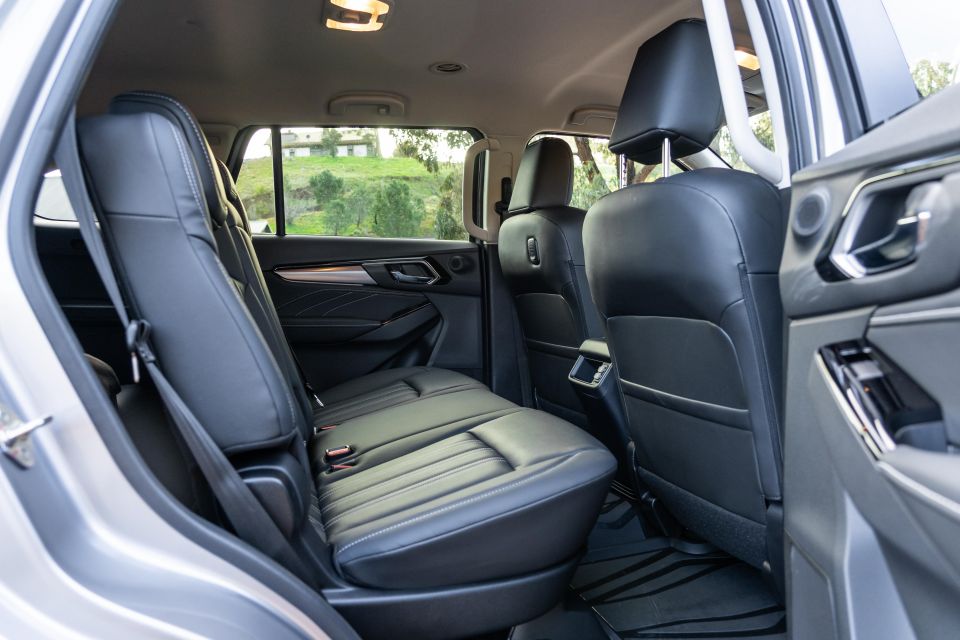

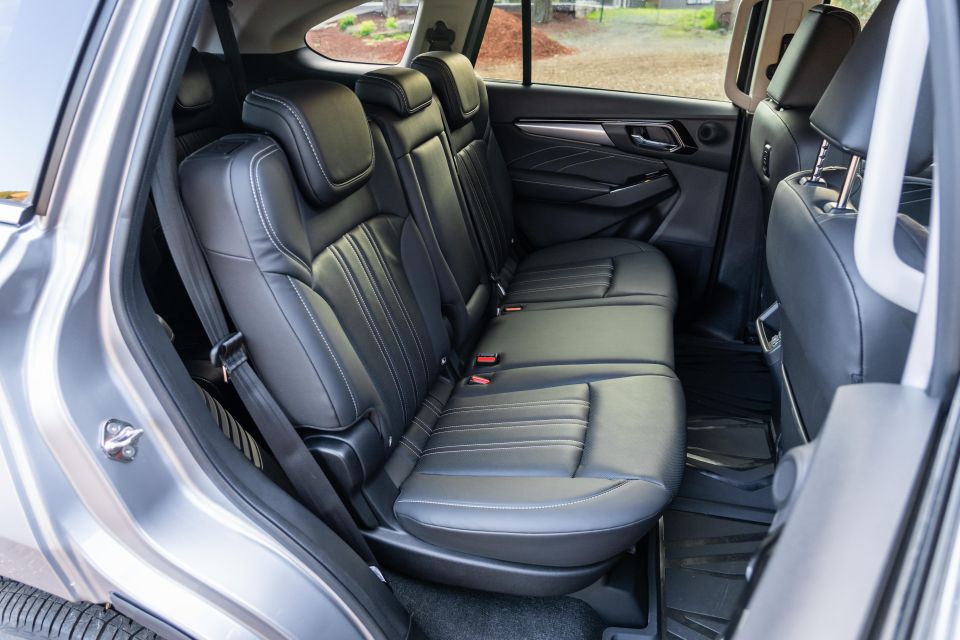
Grievances? There’s an excessive application of piano black trim all over the dash and tunnel that acts as a magnet for dust and scratches, there’s no twistable volume knob, and (weird one here) the sun visor scrapes against the rear-view mirror when you lower it at dusk.
To the middle row. It certainly passes the family test, with a more forward B-pillar adding 25mm to the aperture over the old model. There’s a heap of room for two big burly adults in the outboard seats, which split 60:40 and have tilting backrests. They don’t slide though.
Features include air vents in the roof with fan speed adjustment, two USB points fitted behind the centre console, a centre armrest with pull-out cupholders, sturdy handles on the B-pillars, and a nifty shopping bag hook mounted behind the front-passenger seat.
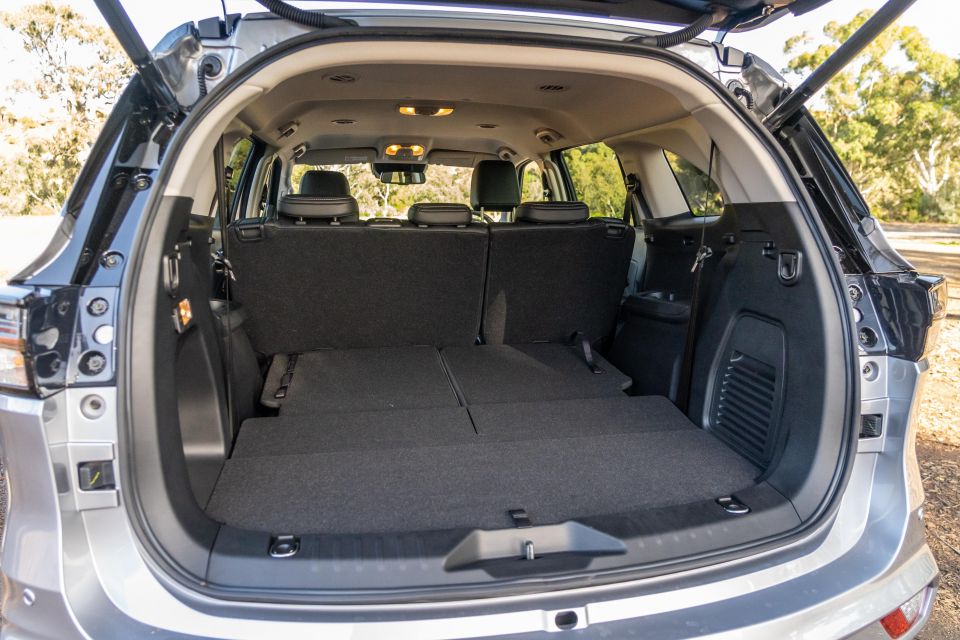
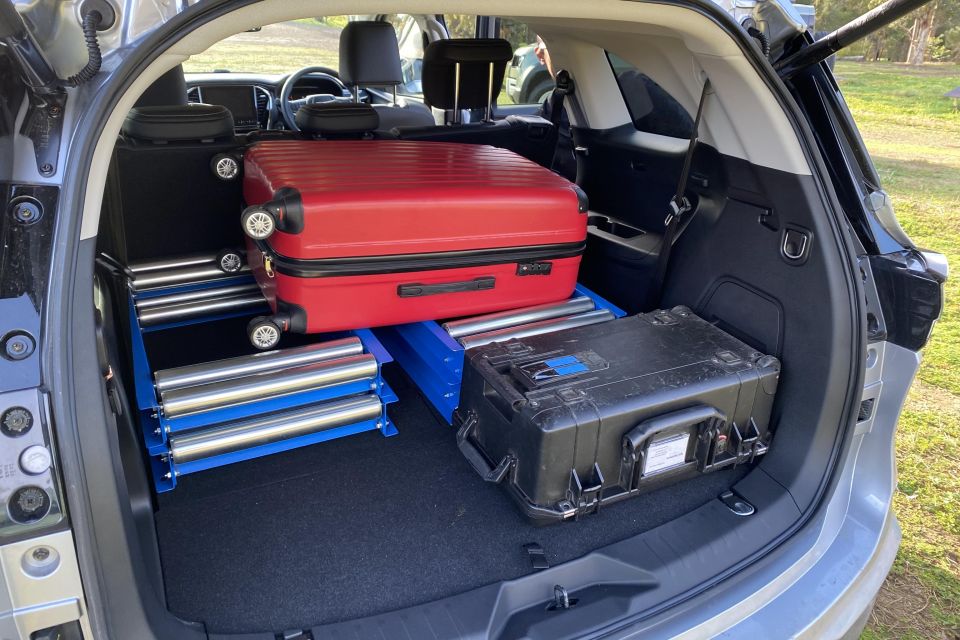
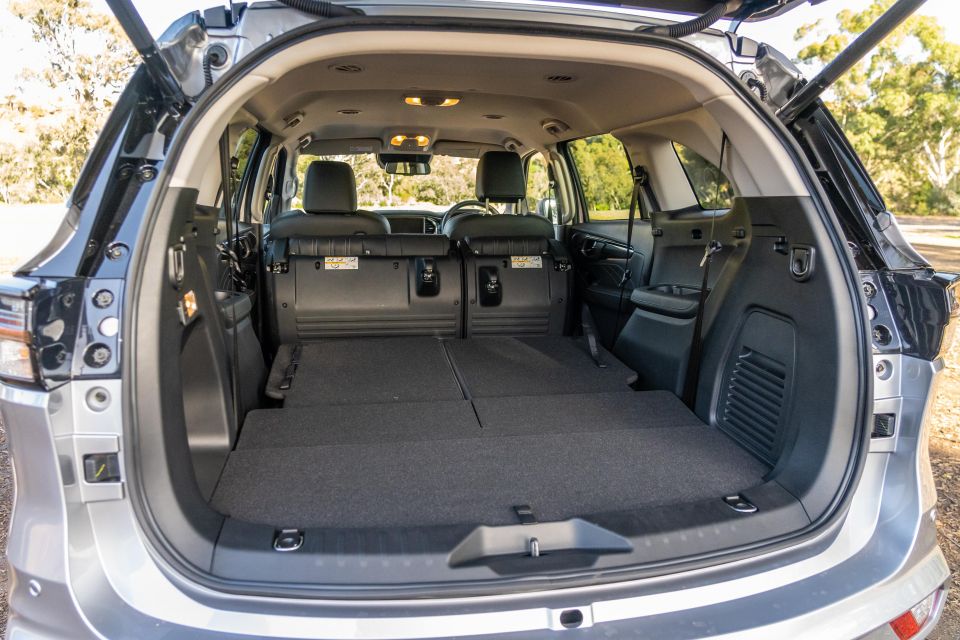
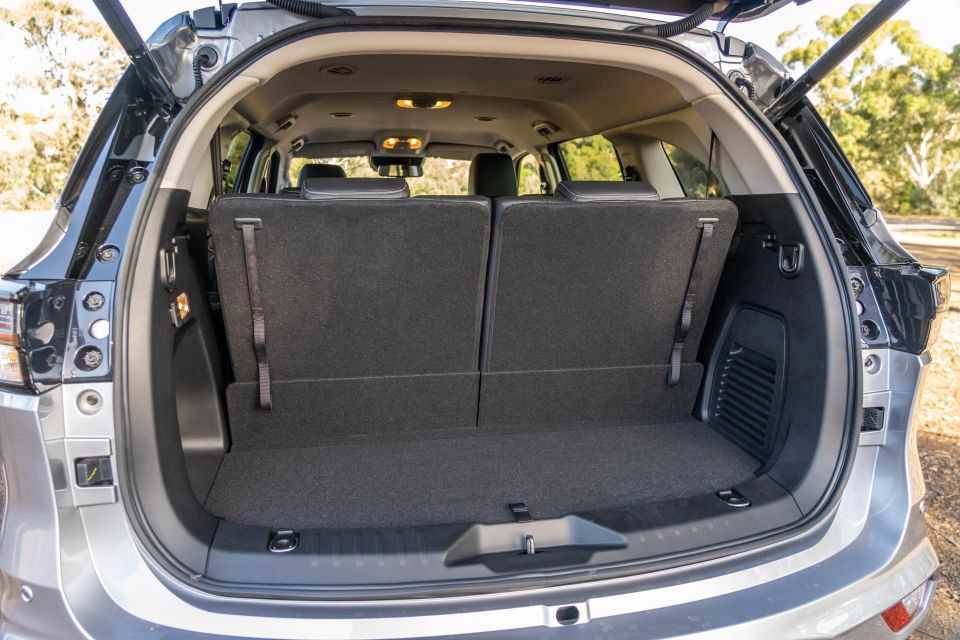
Access to the third seating row is quite generous. One simple pull on a lever tilts and tumbles the larger kerbside portion, revealing a large aperture from which to access the rearmost seats.
It’s impressively spacious – there’s room for two adults at a pinch.
Isuzu claims each rearmost seat is 105mm wider across the back than the old model’s, and they’re comfier than mere afterthoughts. You also get air-conditioner vents in the roof and cupholders in each armrest. However the small rearmost windows do hinder outboard visibility.
When not in use these third-row seats fold neatly into the floor. The old MU-X’s raised boot is gone and with seven seats in use still stows 311 litres (enough for a decent suitcase and a few duffel bags). In five-seat mode it handles a capacious 1119L, and with five seats down 2138L.
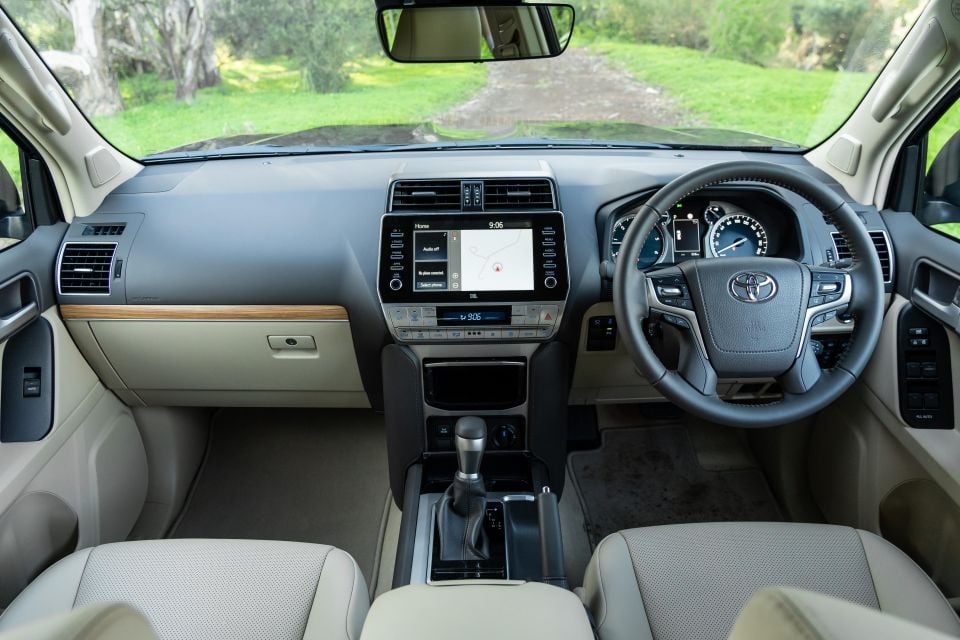
Toyota
Where the MU-X’s interior palette is all blacks, greys and silver highlights, the Prado’s is an old school blend of beige leather, cream carpet, and light woodgrain to offset the dominant charcoal hue.
It’d be hard to keep the seats and floor carpets clean, but to Toyota’s credit you can order black leather and dark floor carpeting.
The materials do feel more rugged and expensive in the Prado and the build quality a little more solid, and small touches like the powered steering column and tactile seat heating and ventilation dials on the centre tunnel are nice.
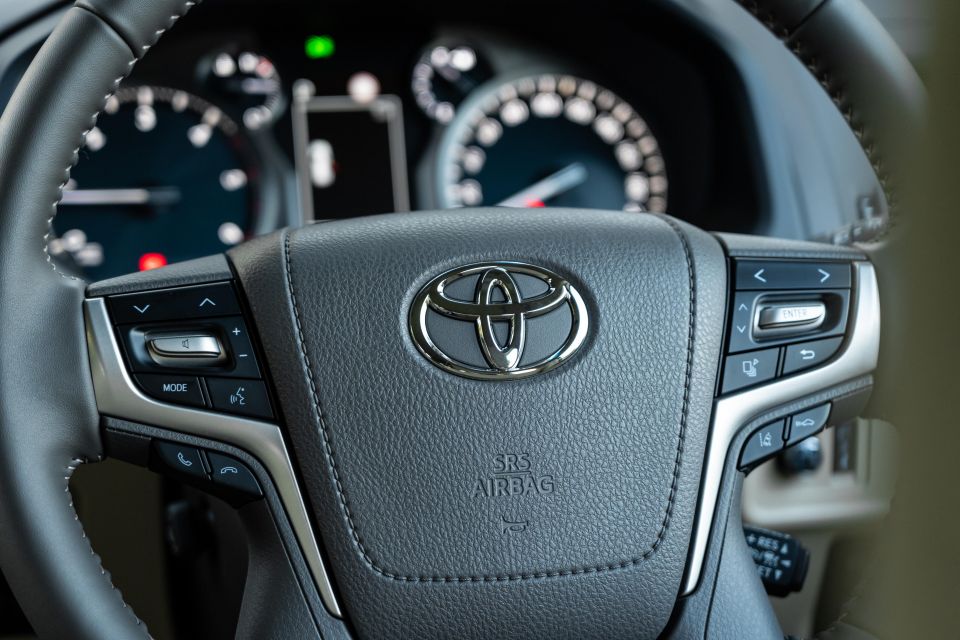
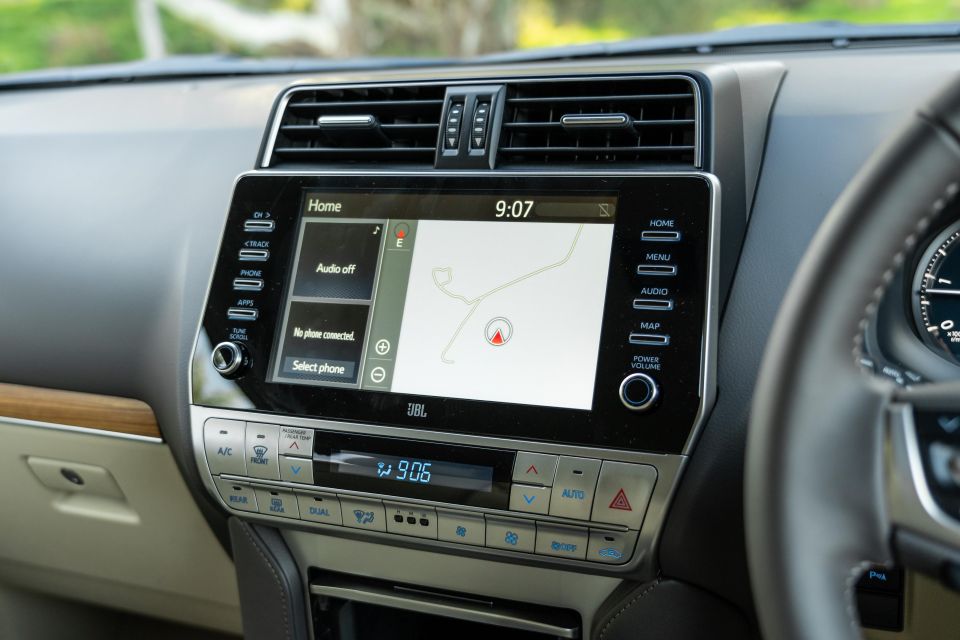
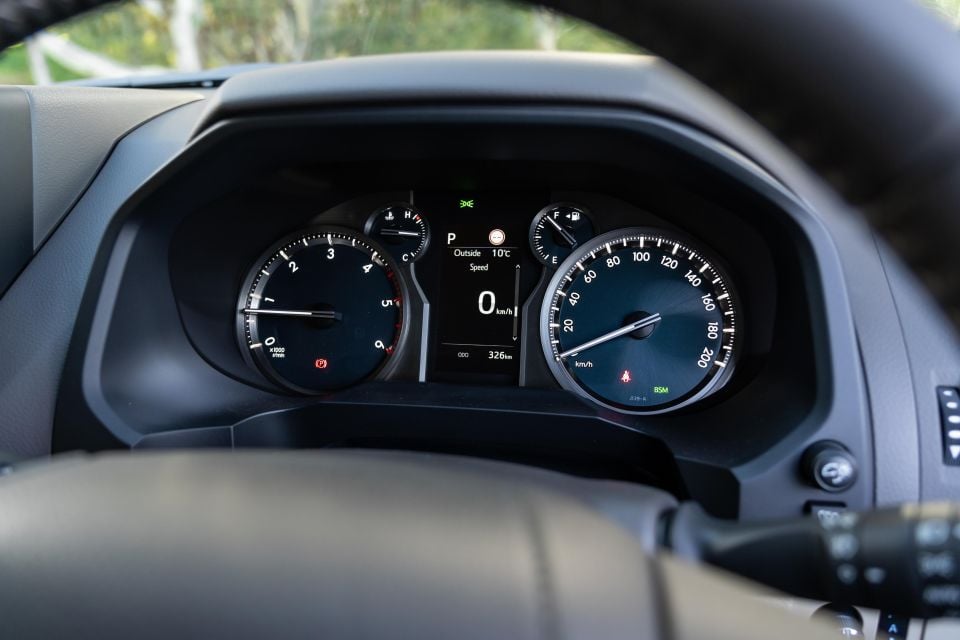
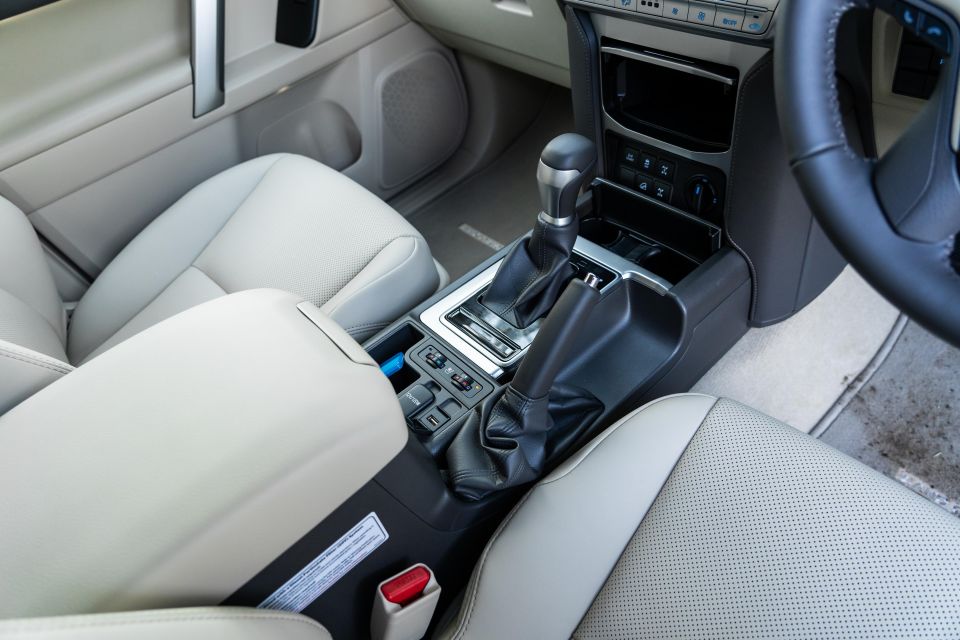
Where expert car reviews meet expert car buying – CarExpert gives you trusted advice, personalised service and real savings on your next new car.
The touchscreen is the same dimensions as the Isuzu’s and comes with both shortcut buttons and a volume dial. It’s also angled in such a way that it avoids wash-out in sunlight more effectively.
I liked the configurable home screen with various tiles, and the 360-degree view camera.
Even small touches like the classier gauges, weightier handles, absence of any trim creaks, and cleaner yet more intuitive layouts stand out. As they should, given the price differential.
Storage options are plentiful, and the absence of a second glovebox is overcome by a deep console that also doubles as a cooler box,
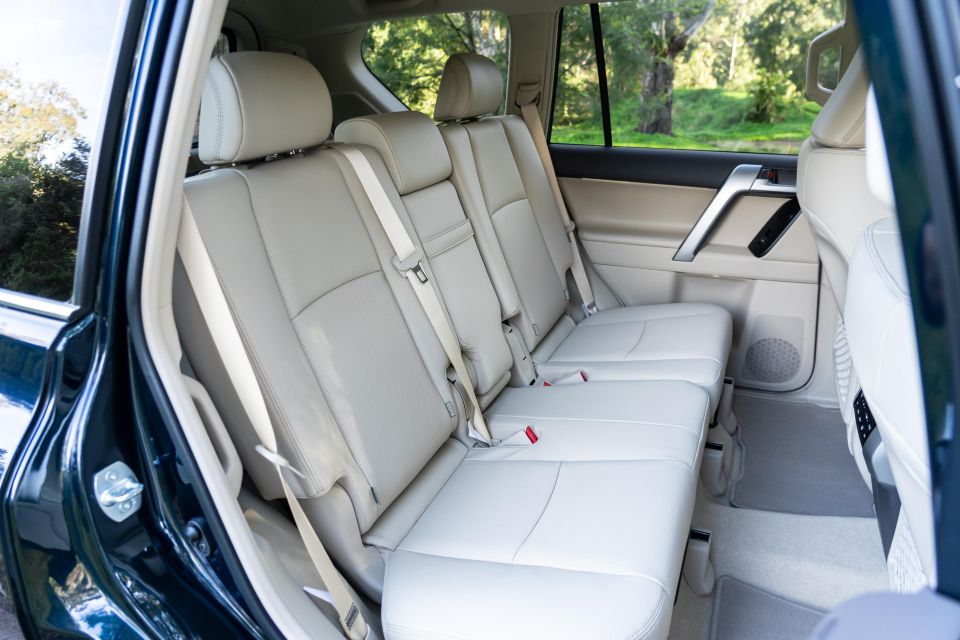
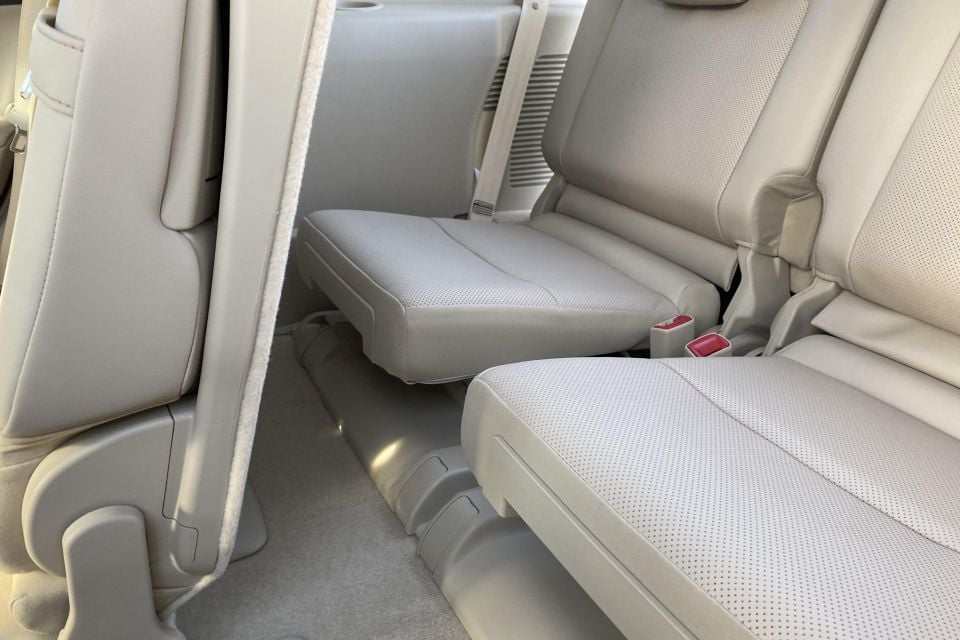
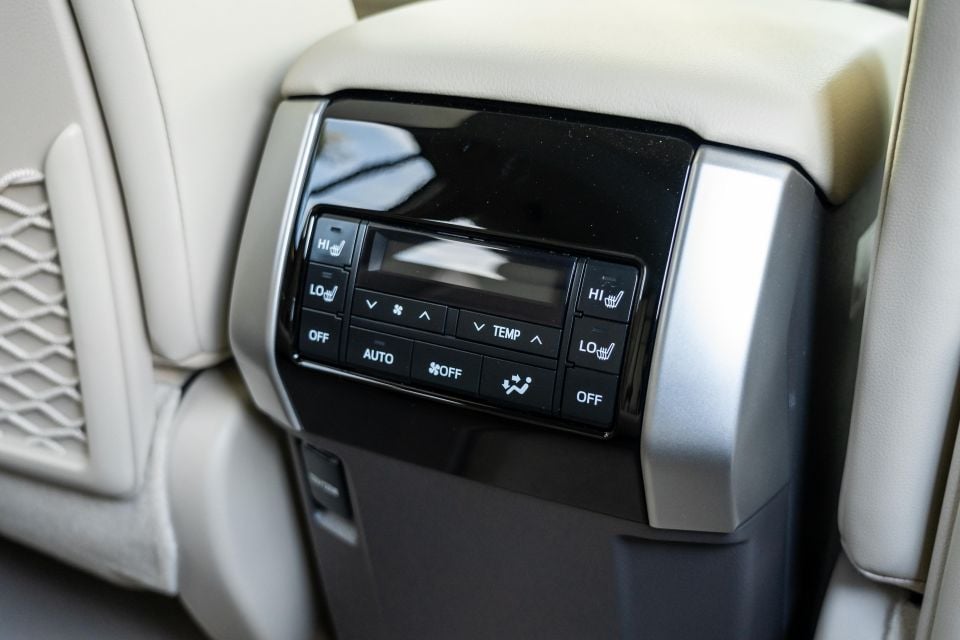
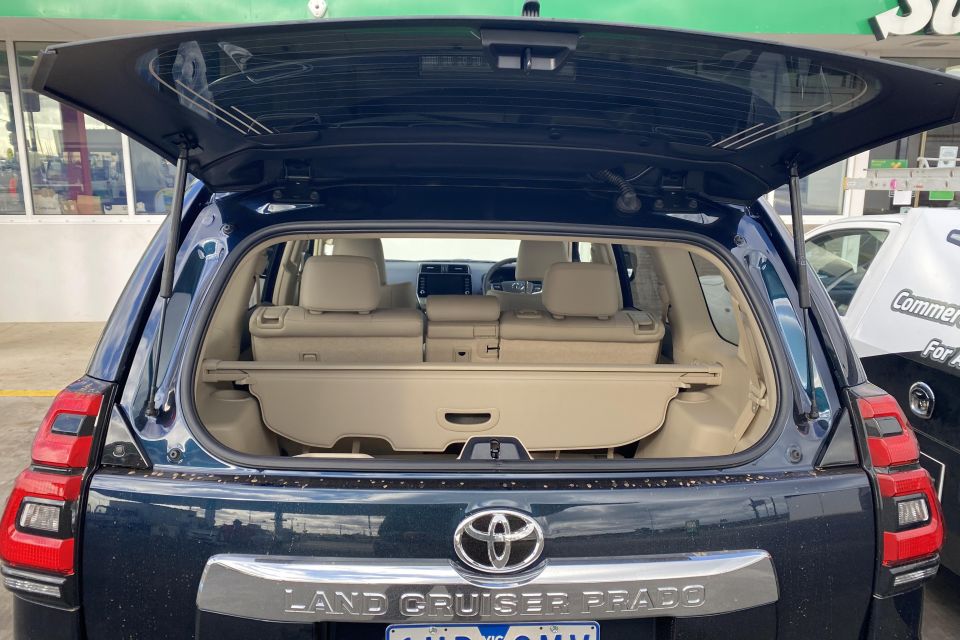
The middle seats are just as spacious in terms of legroom as the Isuzu’s and offer more headroom and greater outward visibility.
There are also vents in the roof and sturdy handles like the Isuzu, and while there aren’t USBs (there’s a 12V) there is a separate cluster of buttons to control the third climate control zone.
Access to the third row seats is harder from the kerbside because the larger portion of the 60:40 split-folding middle bench is located on the driver’s side. The rear seats are also narrower, and thus best used for kids.

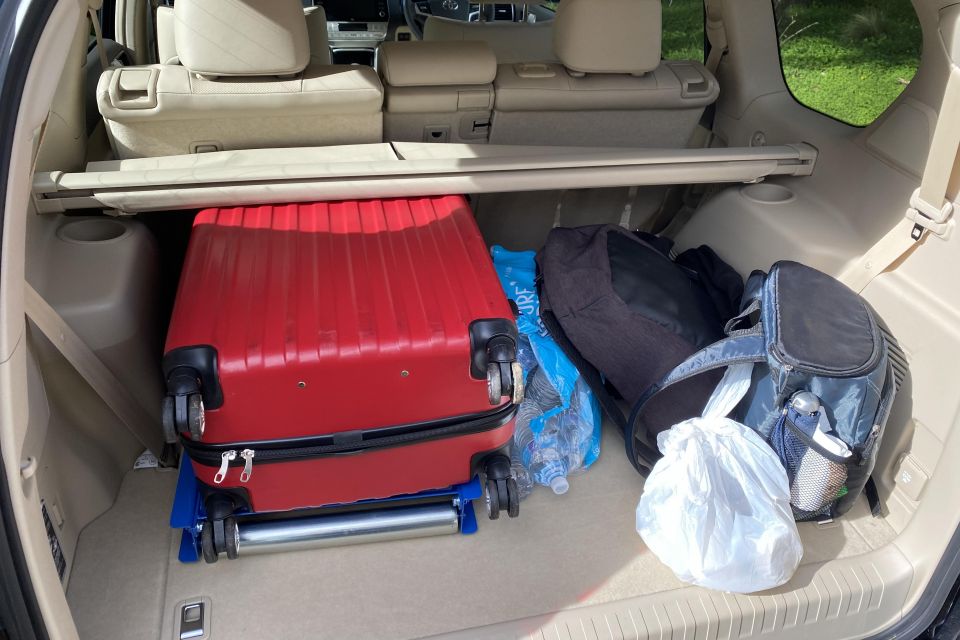
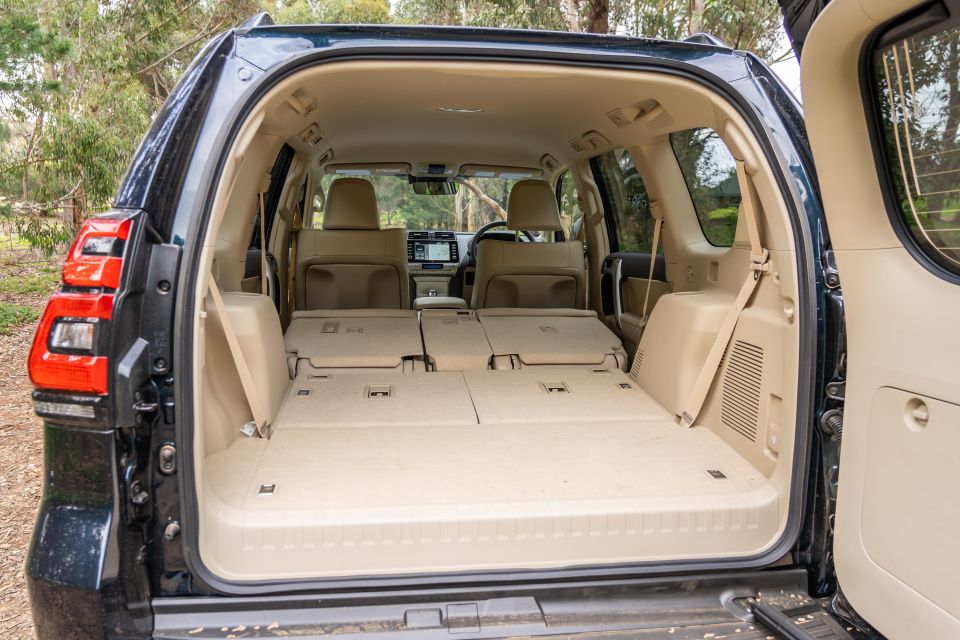

Folding them out of the floor is a two-step process too, with the bases controlled separately to the backrest.
There’s less cargo space behind the third row, and with five seats in use the Prado’s boot floor is shorter.
Our test Prado had the underfloor spare wheel and single tank, meaning a side-opening manual tailgate with a separate glass panel that opens from the top for rapid loading.
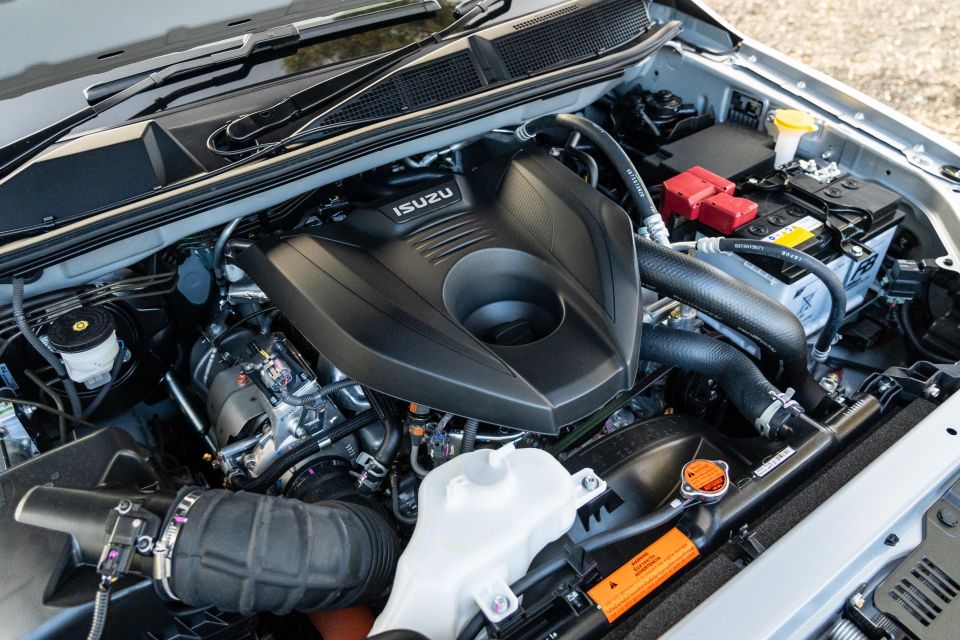
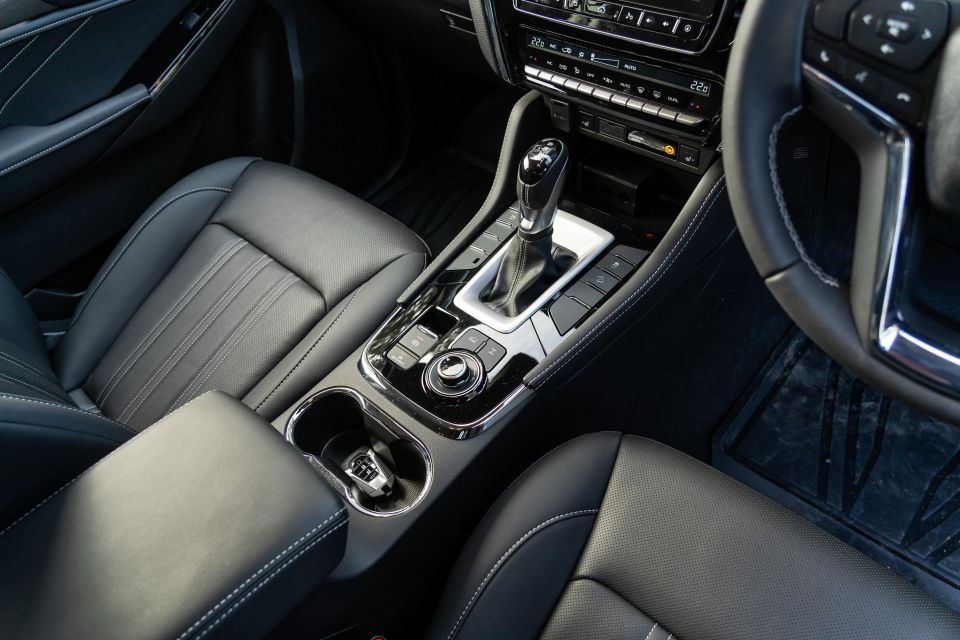
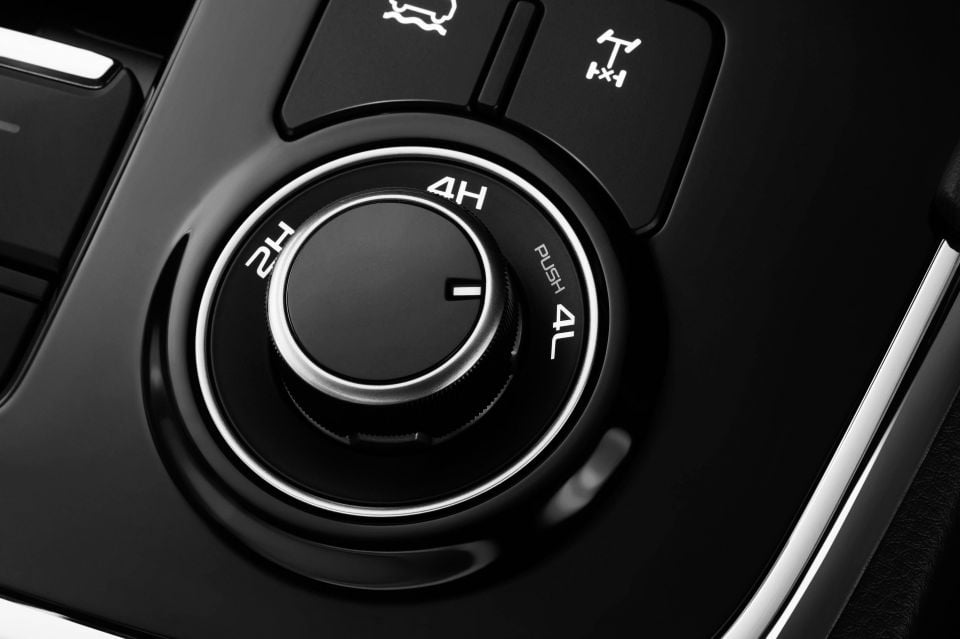

Both vehicles feature four-cylinder diesel engines shared with big-selling utes: the D-Max and HiLux respectively.
Isuzu
The Isuzu’s updated 3.0-litre produces 140kW of power at 3600rpm and 450Nm of torque as early in the rev band as 1600rpm.
It’s mated to a six-speed automatic transmission and a part-time 4×4 system with low and high-range gearing, and a locking rear diff.
Isuzu claims combined-cycle fuel economy of 8.3 litres every 100km, and the tank has been upsized to 80 litres.
The towing capacity is 3.5 tonnes, which is best in class. Even at full payload it’s still rated to lug 3.1 tonnes legally.

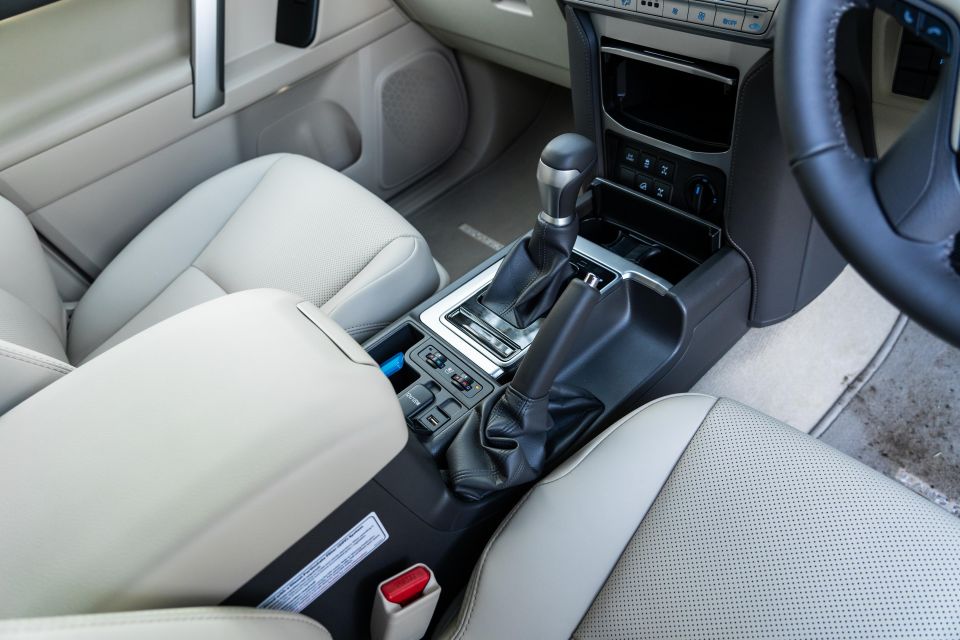
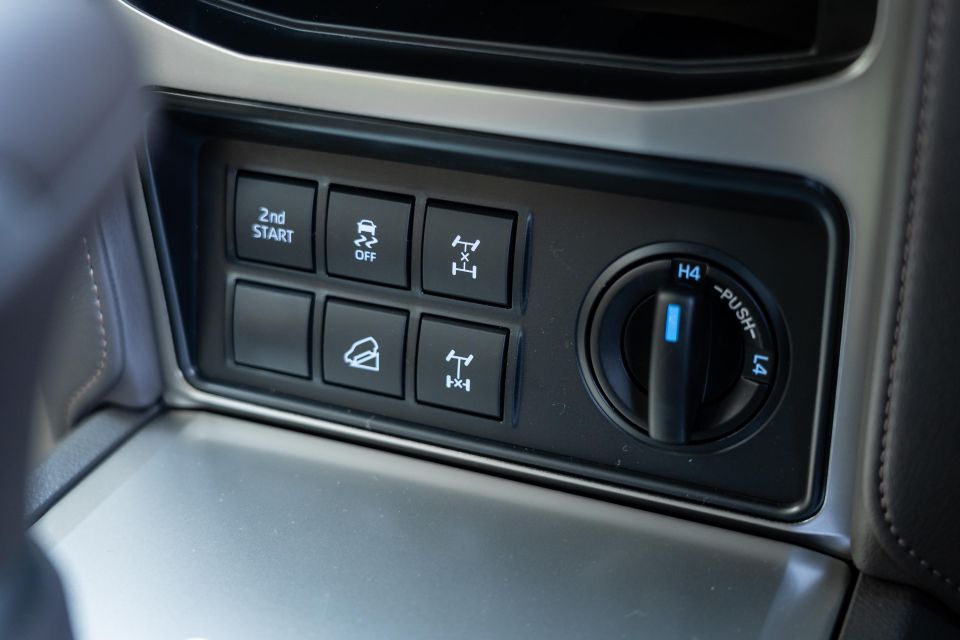
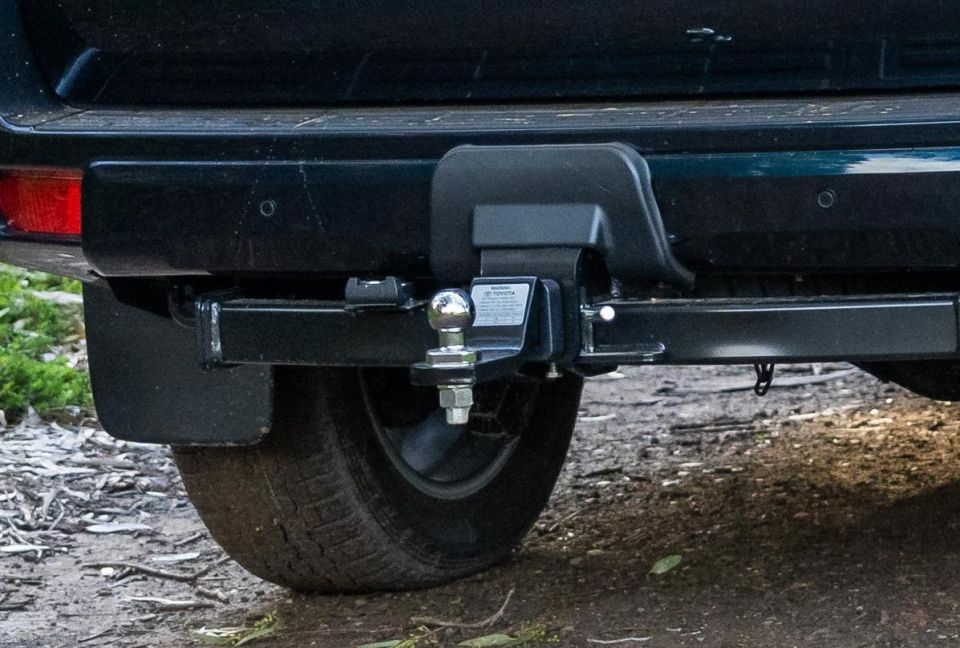
Toyota
The upgraded 2.8-litre engine in the Prado makes more power and torque than the Isuzu: 150kW at 3000rpm and 500Nm between 1600 and 2800rpm.
It’s mated to a six-speed automatic and a full-time 4×4 system with low-range, and lockable diffs both centre and rear.
Toyota claims combined-cycle fuel economy of 7.9 litres every 100km, and the tank is 80 litres in our test car.
However you can opt to buy a Prado with the spare wheel mounted to the tailgate rather than under the cargo floor, freeing up space for a second fuel tank. Diesel capacity in these models is 150L, ideal for anyone doing remote touring.
The towing capacity is 3.0 tonnes, at payload.
| Isuzu MU-X | Toyota Prado | |
|---|---|---|
| Fuel | Diesel | Diesel |
| Displacement | 3.0-litre | 2.8-litre |
| Cylinders | Four | Four |
| Power | 140kW @ 3600rpm | 150kW @ 3000rpm |
| Torque | 450Nm @ 1600-2600rpm | 500Nm @1600-2800rpm |
| 4×4 system | Part-time, low-range | Full-time, low-range |
| Switchable diff locks | Rear | Centre and rear |
| Transmission | 6-speed auto | 6-speed auto |
| Combined fuel | 8.3L/100km | 7.9L/100km |
| Urban fuel | 10.3L/100km | 9.6L/100km |
| Highway fuel | 7.2L/100km | 7.0L/100km |
| Fuel tank | 80 litres | 87 litres, 150L option |
| Towing capacity | 3500kg | 3000kg |
| Kerb weight | 2175kg | 2245kg |
| Payload | 625kg | 745kg |
| Gross vehicle mass | 2800kg | 2990kg |
| Combination mass | 5900kg | 5990kg |
| Towing at payload | 3100kg | 3000kg |
Isuzu
Isuzu’s latest iteration 3.0-litre turbo-diesel doesn’t look like an outlier on the spec sheet, but it performed admirably even though our test car had bare-minimum kilometres on the odometer.
It’s tuned to offer really good response off the mark, and while 450Nm peak torque is middle-of-the-pack, two-thirds of it arrives from 1000rpm. So it feels strong early and stays that way as it slowly works up the rev band.
The Aisin six-speed auto seems well mated to the engine, offering pretty smooth and well-timed shifts. In sixth the MU-X ticked along at 110km/h with 1600rpm on the tacho, so it’s a relaxed long distance cruiser.
It also sounds smoother and quieter, less ‘agricultural’ than the old model, though under heavy throttle it’s more audible through the firewall than the Prado’s engine.

Taking simple decibel readings inside the cabin at full throttle over the same section of road, on the same day, showed 70dB for the Isuzu and 67dB for the Toyota. It’s not a huge difference, but you can tell if you pay attention.
The MU-X had the Prado beat by half-a-second on a 0-100km/h basis. However where the full-time 4×4 Toyota simply moves off the line in prompt fashion, the part-time Isuzu can chirp the rear tyres for a sec if you really mash it.
The fuel economy claim on the combined cycle is 8.3 litres per 100km. I averaged 9.3L/100km over 800km of mixed driving with the engine not yet run-in. A speed average of 39km/h suggests lots of stop/start commuting. Pretty decent really.
From behind the wheel, the most immediate changes on first driving the new MU-X are how much more supportive the seats are, and how much lighter the new electric-assisted steering is than the old hydraulic setup. For urban driving in particular it makes the MU-X far more wieldy.
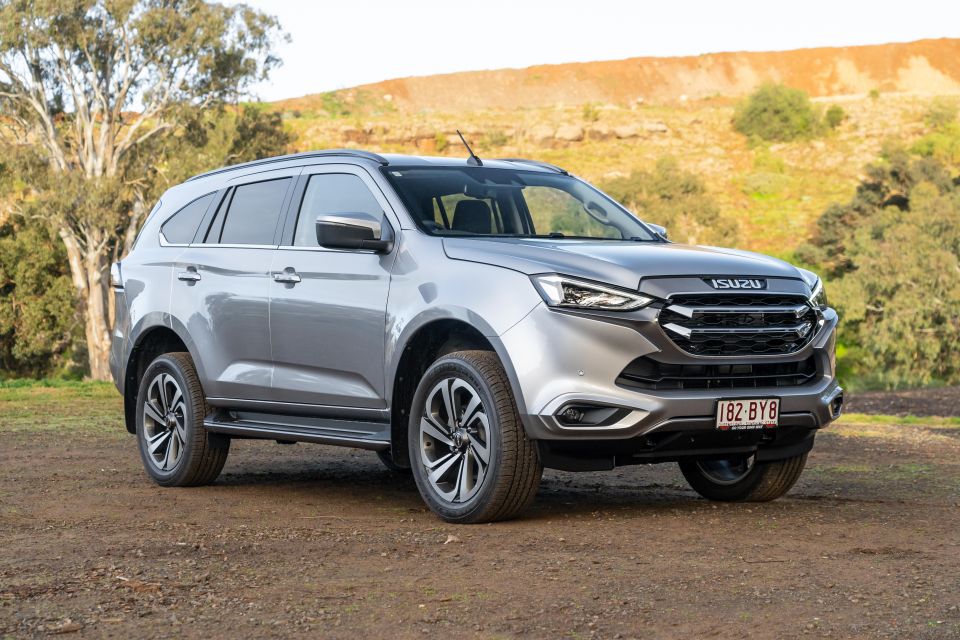
Ride quality is largely respectable even in the LS-T with its big 20-inch wheels and slim-sidewall highway tyres. The body feels stiff and the suspension filtered out most road imperfections nicely, to make this a pretty consummate tourer.
The chassis rails are stronger than before and there’s an extra cross member to stiffen up the frame, more ultra high-tensile steel, and an additional 157 spot welds.
All up Isuzu claims the new MU-X is 10-per cent stiffer than before. With two opposing wheels off the ground (4×4-ing), the doors had no issue closing.
The suspension setup comprises double wishbones up front with a stabiliser, and a rear axle with five linkages and coils – unlike the D-Max ute’s rear leaf springs. Isuzu says the rear has a stiffer anti-roll bar than before, and a higher spring rate.
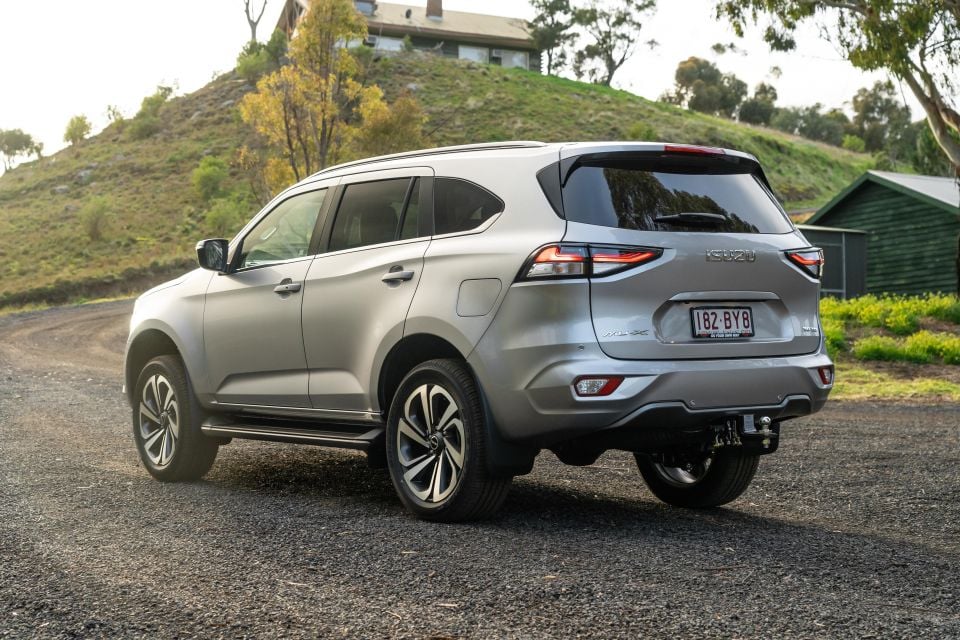
That said, over undulating B-roads it also never feels quite as calm and settled as the even smoother Prado, with body movement evident.
Both vehicles on test are equally well insulated, displaying cabin noise measuring 65dB at a constant 100km/h. Both keep tyre roar at bay but let in wind noise from the mirrors.
In terms of off-roading, the LS-T spec with its road tyres and side steps is clearly not made for bush bashing out of the box. But it’s highly capable at its core, and well supported by both Isuzu’s accessories catalogue and the aftermarket.
Shifting out of rear-drive into high-range 4×4 is done via rotary dial on the fly, and if you need it there’s low-range – and the engine braking is good.
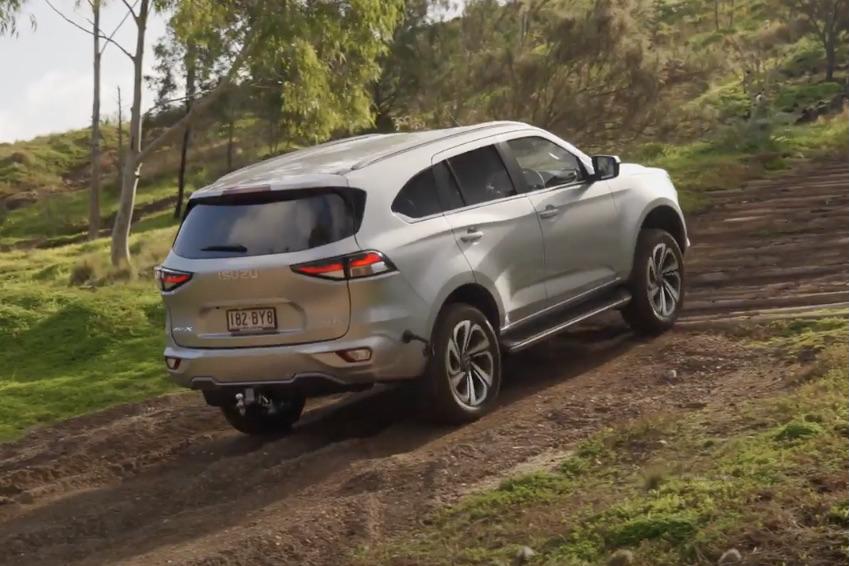
Unlike the old MU-X there’s also a locking rear diff this time, which is sometimes really needed to pull you out of sticky situations by limiting rear wheelspin.
We’d prefer full-time 4WD in place of the part-time system, though.
We clambered up some slippy logs despite the tyres, walked through some offset moguls, and shuffled down a rocky decline chugging along in low-range with hill-descent control activated and effective.
Be sure to watch the video embedded above.
Toyota
As flagged earlier the Prado’s engine is quieter from inside, and while it lacked the immediacy of the Isuzu it ultimately offers more torque across a broader rev range, and still pushes you back in your seat.
Just like the Isuzu the six-speed automatic takes it easy but feels pretty non-intrusive with well spaced ratios, and the throttle calibration feels about right in most situations.
Toyota’s publicised diesel particulate filter issues have been addressed with the fitment of a manual switch, but it’ll still burn off collected particles (like the Isuzu) of its own volition once the engine is up to the right temperature.
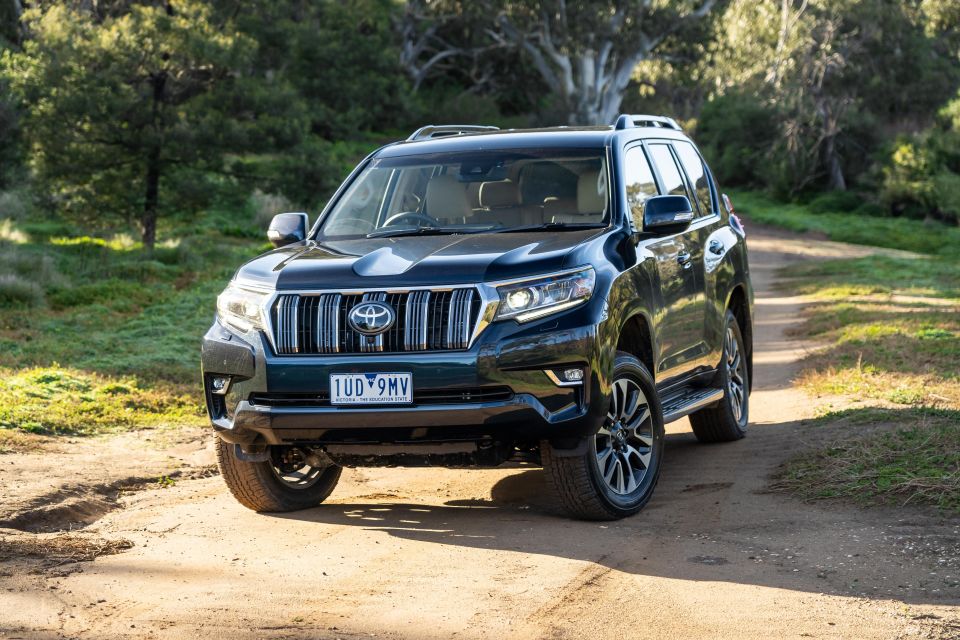
In terms of economy the claim is 0.4L/100km lower than the Isuzu but I in fact averaged 1.1L/100km more over a similar loop, though the engine was very low in miles and possibly needed some more running in.
So in short, the Toyota is more refined but a little more leisurely.
Right away a few things about the Prado feel very different to the MU-X. The steering wheel feels larger and its hydraulic power assist system means it’s heavier to turn. There’s more glass so outboard visibility is clearer. And there’s an older-style hydraulic handbrake to release.
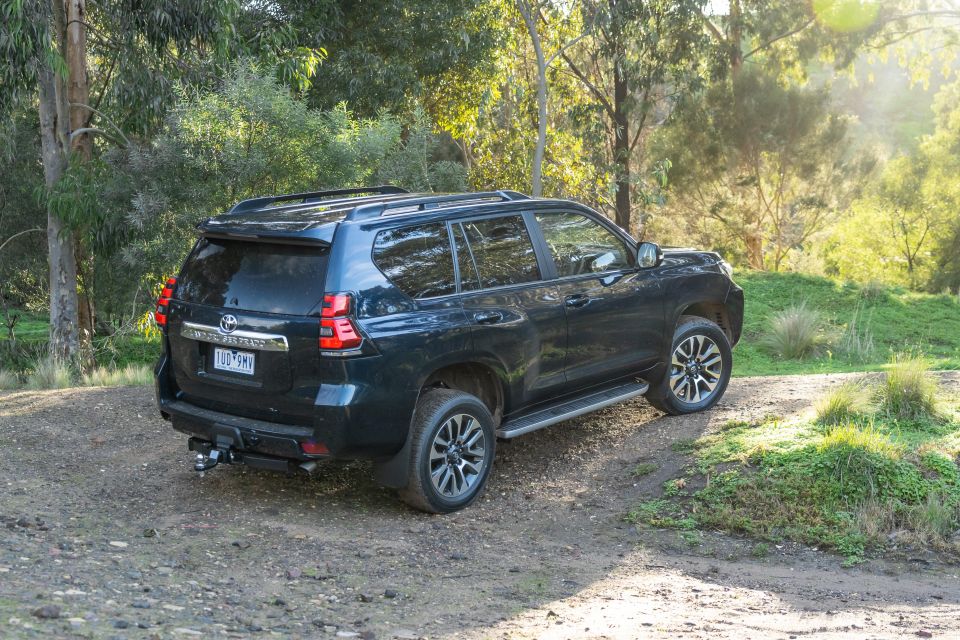
Gee it wafts along well, quietly and with absolute composure over long undulated surfaces. It also does a great job of rounding off smaller and sharper inputs, perhaps down to its tyres with more sidewall for insulation.
The VX’s suspension setup looks similar to the Isuzu – double wishbone front and five-link rear with coils.
The Prado Kakadu comes with rear air suspension and trick anti-roll bar decouplers for greater degrees of articulation if you want something a little extra.

From an off-road perspective the Prado’s reputation goes back a long time, and there’s no brand with more aftermarket or OEM support.
The always-on 4×4 system defaults to high-range but can be switched to low-range at standstill in neutral. The centre diff can be locked for soft surfaces, in addition to the rear-torque-limiting rear diff lock.
It’s every bit as capable as the MU-X off the beaten path aside from a slightly lower wading depth, and its OEM tyres are better suited. Note that it also has 120kg more payload.
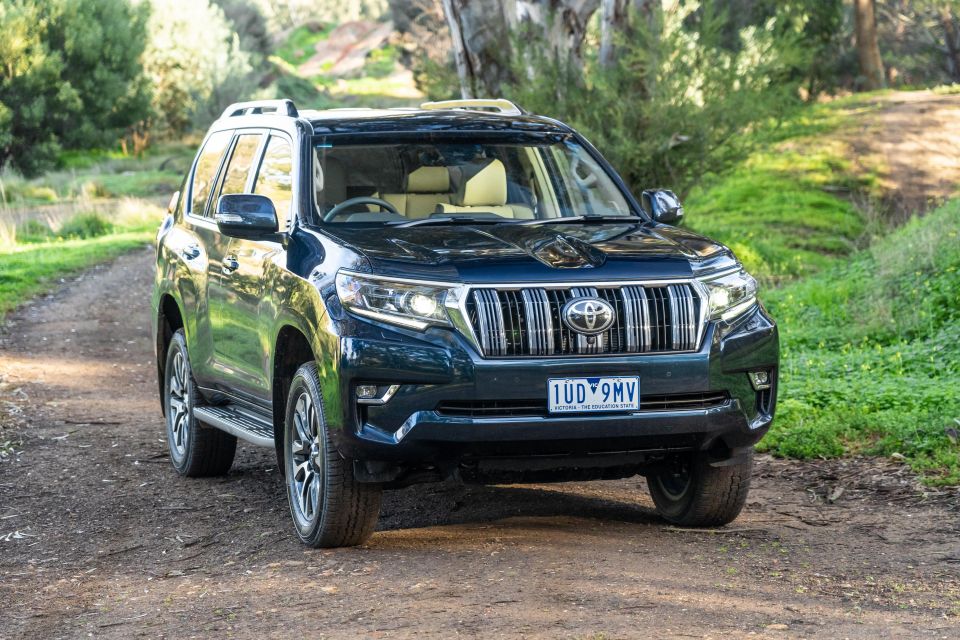
| Isuzu MU-X | Toyota Prado | |
|---|---|---|
| Length | 4850mm | 4825mm |
| Width | 1870mm | 1885mm |
| Height | 1825mm | 1880mm |
| Wheelbase | 2855mm | 2790mm |
| OEM tyres | Bridgestone Dueler H/T | Dunlop Grandtrek A/T |
| Front suspension | Double wishbone, stabiliser, coils | Double wishbone, stabiliser, coils |
| Rear suspension | Rigid, multi-link, coils | Rigid, multi-link, coils |
| Front brakes | Ventilated discs | Ventilated discs |
| Rear brakes | Ventilated discs | Ventilated discs |
| Power steering | Electric assist | Hydraulic assist |
| Clearance | 230mm | 219mm |
| Approach | 29.2 degrees | 30.4 degrees |
| Departure | 26.4 degrees | 23.5 degrees |
| Breakover | 23.1 degrees | 21.1 degrees |
| Wading depth | 800mm | 700mm |
| Turning circle | 11.4m | 11.6m |
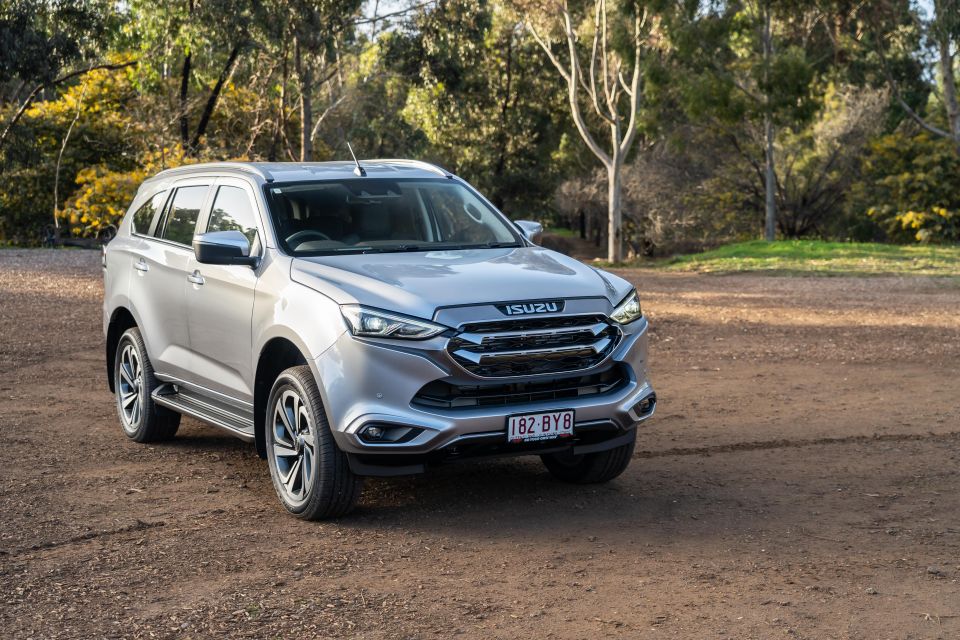
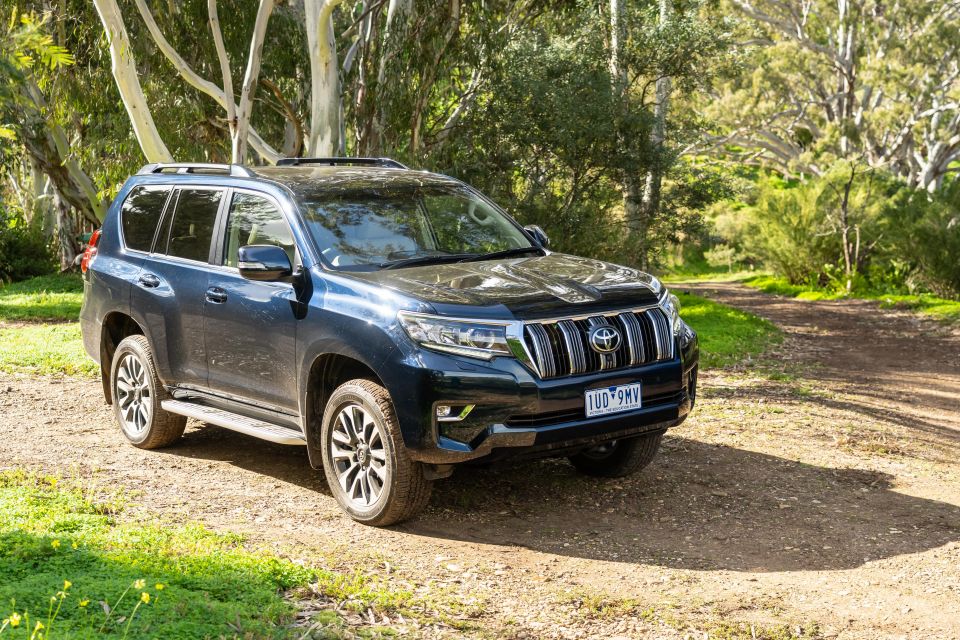
Isuzu provides a six-year, 150,000km warranty.
Services are due every 12 months or 15,000km. The prices for the first seven visits at present are: $389, $409, $609, $509, $299, $749, and $409.
Toyota provides a five-year, unlimited kilometre warranty, extending to seven years warranty for the engine if you stick to the dealer service schedule.
Services are due every six months or 10,000km. The prices for the first six visits at present are: $260, $260, $260, $260, $260, and $260.
While each of the Prado’s services is cheaper, they’re needed more regularly. If you travel 15,000km per year, the first three years of servicing in the will cost $1407 across three visits for the Isuzu, and $1560 over six visits for the Toyota.

This new Isuzu MU-X in LS-T guise as tested, isn’t quite the bargain the old car was. But you largely get what you pay for.
In some ways it’s actually more convincing than the Prado: it feels more responsive off the mark and is rated to tow more, there are more safety features, its third-row seats are roomier, and its service intervals spaced further apart.
It’s also around $20,000 cheaper on the road than an equivalent Prado VX and $10,000 cheaper than a less richly-specified Prado GXL. Which means it’s the value-for-money choice.
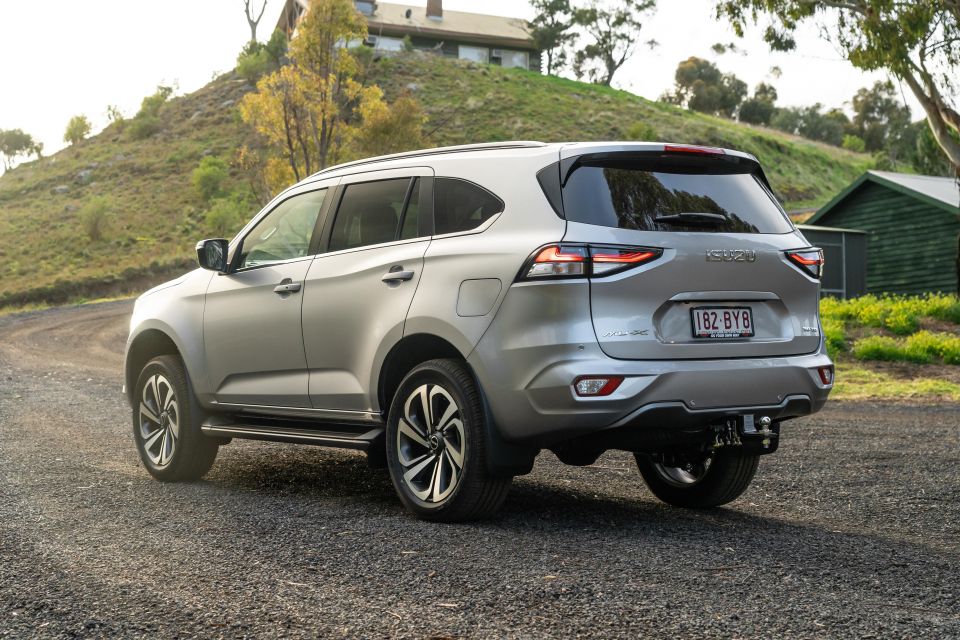

With all that said the Prado doesn’t just use brand credibility to justify its premium price.
Its interior feels classier, its road manners more composed, it can be ordered with a second tank for long-hauling, its 4×4 system is better, and in my subjective opinion is has more presence.
If budget weren’t a core consideration I’d take the Toyota, but the Isuzu is a stronger alternative than ever and therefore delivers what it promises.
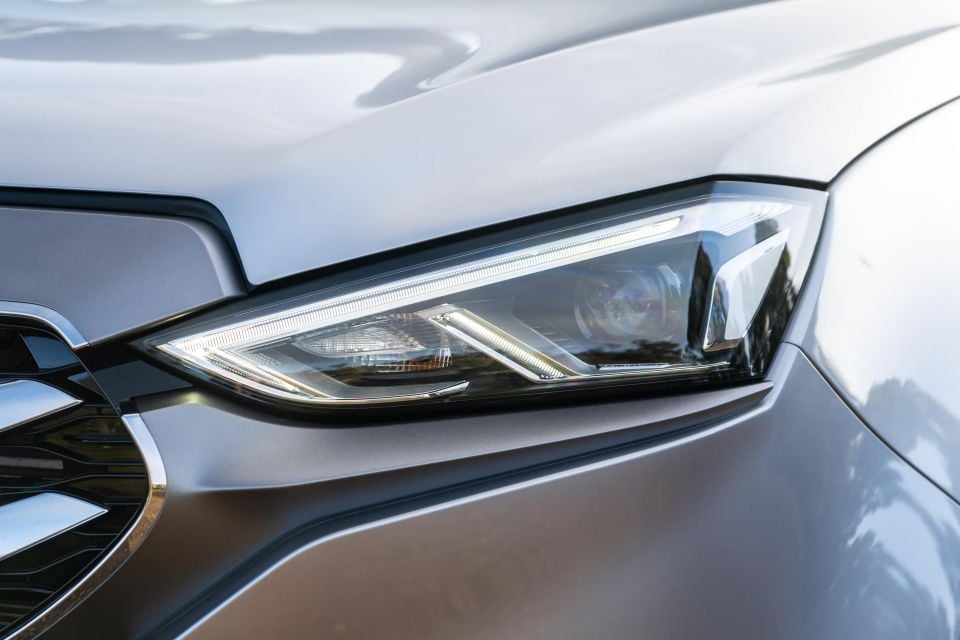

Click the images for the full gallery
MORE: Everything Isuzu MU-X MORE: Everything Toyota Prado
Share your thoughts with us in the comments below!
Share your thoughts and write a review of a car you own and get featured on CarExpert.


William Stopford
1 Hour Ago


Ben Zachariah
2 Hours Ago


Derek Fung
3 Hours Ago


Matt Campbell
9 Hours Ago


William Stopford
1 Day Ago


Josh Nevett
1 Day Ago